Schumann Piano Quartet in E-flat major
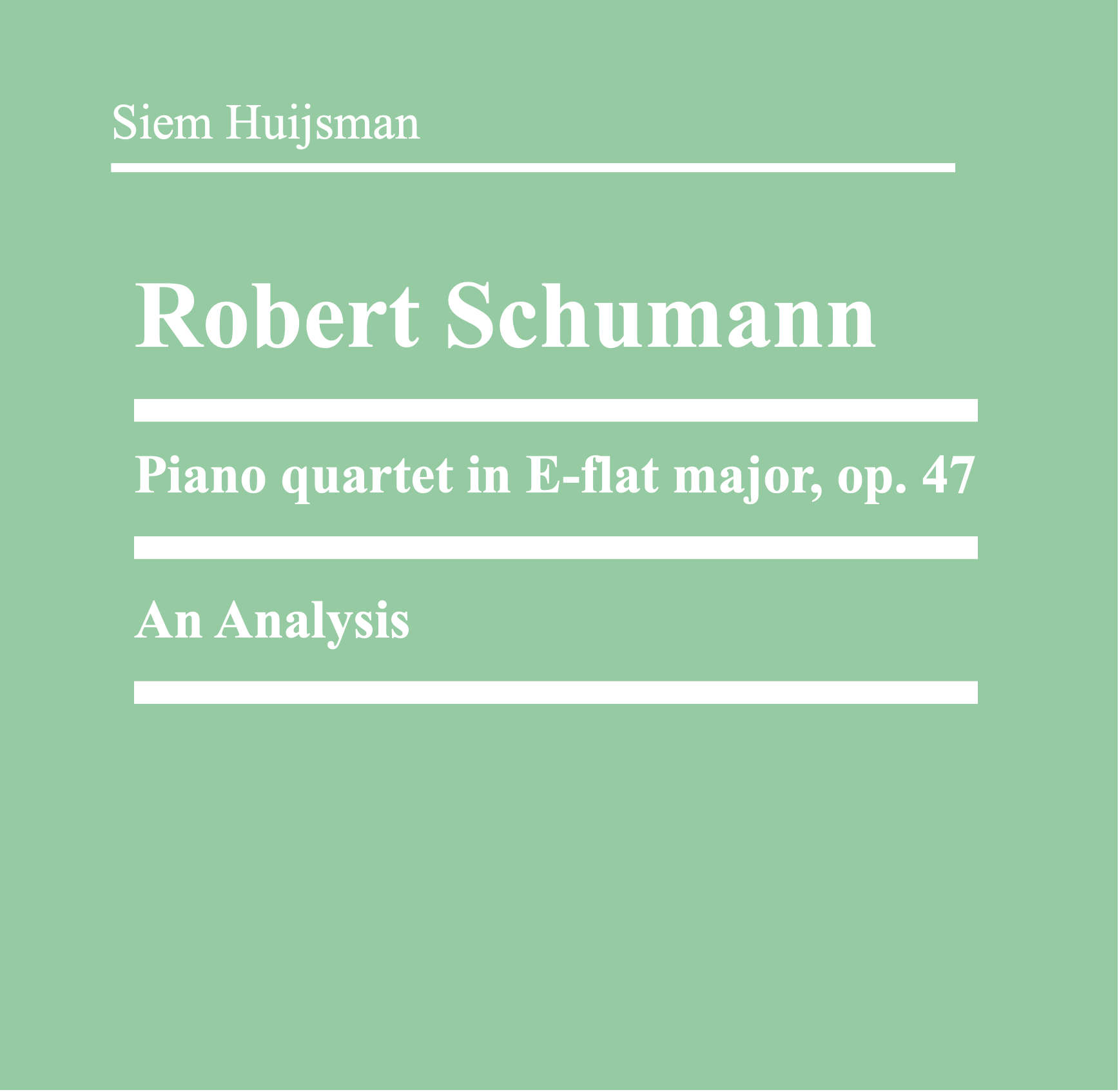
Last updated on January 19th, 2025 at 03:04 am
Introduction
Robert Schumann (1810-1856) was known for having periods or even years in which he composed a certain genre of music. The year 1842 has become known as the chamber music year in which Schumann composed three string quartets op. 41, the piano quintet op. 44, the piano quartet op. 47 and the Phantasiestücke for piano trio op. 88. The piano quartet is the subject of the present analysis.
I have tried to make the text also understandable for music amateurs who want to get a better understanding of the music they play, or for that matter listen to. Therefore I sometimes include the approach I used to examen and analyse certain sections.
I want to thank Menno Dekker – my former professor at the conservatory of Amsterdam – for the very useful discussions I have had with him about this analysis. I am very grateful to have the opportunity to drink in upon his incredible knowledge of music theory.
Practical information
In this text a lot of references are made to the score of the piano quartet. This is done by means of an identification of the movement and the measure number within that movement. Ideally you have a score with measure numbers at your disposal. A score can easily be downloaded from IMSLP.
In general notes on analysis you can find some remarks on abbreviations, notation and concepts. Some books that I have been consulting can be found in consulted literature. At least all references made to literature in the notes should relate to entries in the consulted literature. The music examples are made in Musescore 3 and 4.
As for the notational convention of major and minor keys: I will use capitals for major keys and lower-case letters for minor keys. For major keys I will often add the word major and for minor keys the word minor, but in music examples and diagrams the words major and minor will in general be omitted. So B major or B for B major and b minor or just b for b minor.
I’m still trying to find a proper way to show figures as pop-up when hovering over the text “fig.x”, but haven’t found it yet. For now whenever a reference is made to a figure I linked the picture and it opens in a new tab. You can use “go back” button of your browser to return to the spot where you started. Not ideal but it is the best I can think of for now.
Finally it must be mentioned that although automatic adjustments are made to view these posts on tablets as well as mobile phones, they can best be accessed on a computer/laptop. The reason is that there are various tables and lists (like abbreviations) of which the columns will appear one beneath the other (especially on a mobile phone). If that is the case the coherence will be lost.
Table of contents
The table of contents gives an overview of this analysis and allows you to access the mentioned subjects with just one click. On the lower right hand site of the post there is a green button with an arrow pointing upwards. You can use it to return to the top of the page for a quick access to this table of contents.Motives
First movement: Sostenuto assai – Allegro ma non troppo
Getting a feeling of the global structure
When trying to discover a (not to mention the) structure of this first movement we might just listen to it and perhaps have the score at hand while listening. To be honest, when listening to a piece of this era I always have the sonata form structure at the back of my head.
At first site and listening there are probably already a few major landmarks that draw our attention. Remember that this is a piece in E-flat major the home key of the quartet and thus of this movement.
The movement begins with a slow introduction Sostenuto assai, mm.1-12 (fig.1) and then an exuberant Allegro ma non troppo bursts out, m.13 (fig.3). A lot of different things happen and then the slow introduction recurs (Sostenuto, m.125). Here you might wonder: is this the repetition of the exposition? However, the end of the sostenuto, m.135 (fig.21) with the A natural and the key change at the beginning of the Allegro make clear that this is not the case. The ‘sonata form-mind’ suggests that this is the beginning of the development section.
The climax in mm.208-212 (fig.28) and again a key change back to three flats (E-flat major, m.213) suggest another major turning point in this movement, and indeed the ‘sonata form-mind’ might suspect the recapitulation. Again a lot of things happen and we might recognize motives and themes from the exposition. Then one last surprise catches our attention: the più agitato at the end of m.320. A clear feeling that the end of the movement is nearby emerges and indeed after a final reminiscence of the main motive (mm.338-346) the movement comes to an end. I think this più agitato is a coda.
So far so good! The main elements of the three part model of the sonata form have been indicated (exposition – development – recapitulation) but there are other elements of the sonata form that have not been mentioned yet. So what about the transition and second theme group or second tonal area (STA)?[1]First tonal area (FTA) and Second tonal area (STA) are terms introduced in Steven G. Laitz, The Complete Musician: An Integrated Approach to Theory, Analysis and Listening (4th Ed (New York [etc.]: Oxford University Press, 2016), 632.
To find those an investigation in the exposition is needed as this is the part in which they would typically appear first (the other part being the recapitulation).
Looking for rest points or changes of texture the first spot to consider is the ritardando and Tempo I in mm.25-26 (fig.3). From the third beat of m.25 onwards a transition is being made to f minor (the super tonic (ii) of E-flat major) and then in m.26 the opening motive is repeated in f minor. So this might be the start of a transition but when looking ahead at mm.34-35 (fig. 5) we find ourselves wrong-footed. In these measures we find a perfect authentic cadence (PAC) in E-flat major, so back we are in the home key of the movement.
Could m.35 be the start of something new (fig.6)? There certainly is a change of texture with the running quavers and then the lyric theme in the cello. However, the key is still E-flat major, and the motive (as we will see later) is the main motive in a legato form.
So on we move to a half cadence (HC) again in E-flat major in mm.51-52 (fig.6). This is followed by a repetition of the opening statement of the Allegro ma non troppo (m.13) which ends in another PAC in E-flat major in mm.63-64 (fig.8).
Thus so far there have been some variations of the main motive and some excursions to different keys but in the end we return safe and sound to the opening theme in the home key of E-flat major.
But then from m.64 second beat onwards (fig.13) there appears to be something really different from the preceding material. The start is in D major which turns out to be the dominant of g minor (m.65). g minor can both be seen as the mediant of E-flat and as the relative minor of B-flat. Why B-flat? B-flat is the dominant of E-flat and the ‘sonata form-mind’ at least wonders if we will encounter something of a second theme group in B-flat. Looking at the ascending scale motive (mm.64-65): this is also completely different from the motives we have seen thus far.
So where are we? Is m.64 the start of the transition? Could be. But then of course the question is: a transition to what? The answer to that question is not obvious. If we stick to the assumption that the development starts in m.125 then somewhere in the passage between m.64 and m.125 must be the point where the transition leads to. This is hard to find. The ascending scale motive pervades the whole passage. Harmonically the passage goes off in g minor and after quite some wandering it stabilizes on B-flat major. The first time B-flat occurs is in mm.82-83 (fig.14). It is a chord in first inversion and bounces off immediately to the dominant F major. A firm cadence in B-flat major only appears in mm.118-119 (fig.18). But the function of the B-flat major chord changes immediately in the dominant of E-flat in m.121 and the introduction of the development has started.
So if we want to see m.64 as the start of the transition, then it is a transition that leads to … the development. So no second tonal area (STA) in this movement. Remarkable!
Table 1 gives the overview of the first movement as far as we know it now.

What follows is a more detailed analysis that will start with the slow introduction and the first tonal area.
The slow introduction
Figure 1 shows a reduction of the slow introduction (mm.1-12). The form is a 3+3+6 sentence like construction.[2]The concept of sentence as theme type can originally be found in Arnold Schönberg, Gerald Strang, and Leonard Stein. Fundamentals of Musical Composition (London: Faber and Faber, 1967), 21 and is further explored in William E. Caplin, Classical Form: A Theory of Formal Functions for the Instrumental Music of Haydn, Mozart and Beethoven (New York [ect.]: Oxford University Press, 1998), 37-39. A brief introduction to the concept of sentence can be found here.
Although deviating from the standard 2+2+4 sentence structure the ratios are the same: 1:1:2. The basic idea is stated in mm.1-3 in the tonic and the repetition in mm.4-6 is in the dominant. This is called a statement-response type sentence. The continuation (mm.7-12) consists harmonically of a predominant (PD) – dominant (D) progression and ends on a half cadence (HC): a question mark and invitation for the main theme in the Allegro ma non troppo. Roman numerals between brackets indicate a chord with a function related to the chord to come. So in m.8 the (V65) is a dominant seventh chord for the IV to come.
In mm.9-12 Schumann uses liquidation (i.e. eliminating characteristic features of the motives until there is only a dominant chord progression left [mm.11-12]).
In mm.8-10 the E-flat is a common tone (made green in fig.1), used in the progression from the predominant IV to the ivMD chord (a chord with modal mixture, see concepts) and firmly establishing the home key. The soprano and bass make a stepwise contrary motion which leads the IV to ivMD.
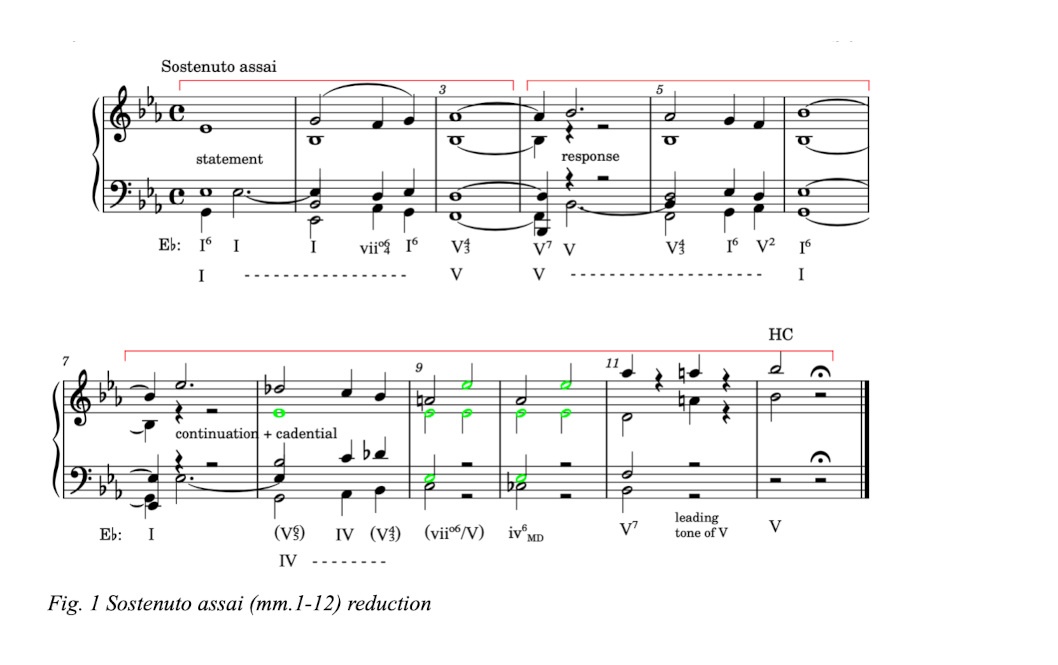
Some other characteristic features can be pointed out. First of all the minor six leap in m.1 in the bass. It feels like the piece starts of the ground (I6), more or less floating in stead of beginning with a firmly grounded I. This leap becomes an octave leap, but the gesture is the same. We will encounter this gesture later on in the movement as well.
Figure 1a shows a diagram of the sentence of the introduction. All elements mentioned before can easily be found.
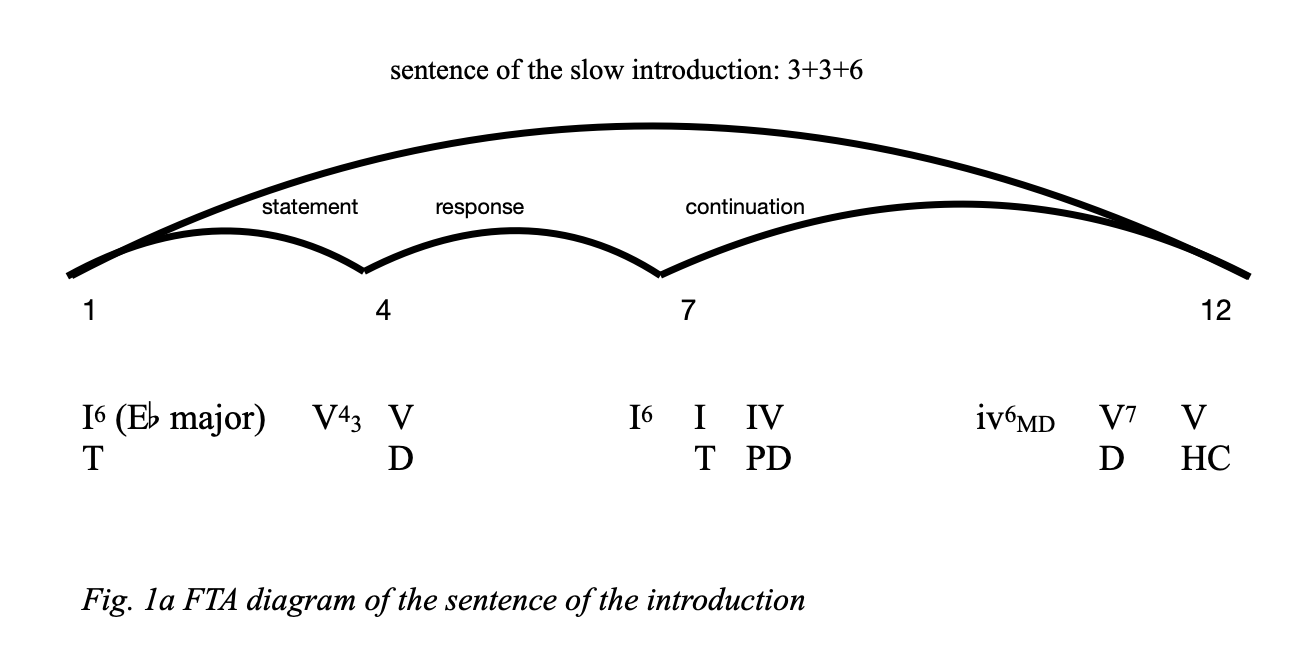
And then there is the motivic material to look at. Figure 2 shows two motives a1 and a2 in the presentation of the sentence. The motive a1 might be called the neighbor note motive. The two motives are each others mirror images except for the last note (B-flat) in motive a2: it has a much more open character which leads to the continuation of the sentence.

Exposition
The Main Theme or First Tonal Area (FTA)
FTA: First phrase (sentence with internal extension)
So we are at the start of the exposition and find there the first tonal area (FTA) or first theme group. The theme type of the first phrase (mm.13-26) can easily be determined as again a sentence like structure, this time as 4+4+5. So here the default sentence ratios are changed to 1:1:1,2. The key is the home key, E-flat major, and again we find a statement-response type of presentation (mm.13-20). Figure 3 shows a reduction of the sentence like structure.

The ornamental cadence in the piano is left out (mm.15-16 and mm.19-20), as the harmony stays the same. The continuation and cadential (mm.21-26) starts in E-flat major and modulates to f minor (as mentioned earlier the super tonic (ii) of E-flat). Notice that in mm.24-25 a series of dominant chords in different positions occur, the last one of which (the V43) is used as pivot for the modulation to f minor.
The GER65 chord belongs to the family of augmented sixth chords.[3]See for instance: Laitz, The Complete Musician, 571-572. The IT6 and the FR43 also belong to this family. They are characterized by a double leading tone to the 5th scale degree which is the dominant. In this case these leading tones are the D-flat and the B natural, both leading to C, the dominant of f minor. Therefore the chords of this family usually have a predominant function, as is the case here: a predominant to f minor. The GER65 can also be written as a double diminished seventh chord on the augmented fourth scale degree: #iv65DD. Some prefer this notation. The raised fourth scale degree is in this case the B natural (the fourth scale degree of f: B-flat, raised to B natural).
Motives
Looking at the motivic material in this sentence we find in mm.13-14 (the basic idea) simultaneously two motives: one in the soprano and a contrapuntal one in the bass. Taking a closer look at the soprano motive it seems to be very similar to the neighbor note motive a1. The rhythm is slightly different (the first note has an equal length as the next two) and the articulation is different of course. Nevertheless the kinship is evident. The motive in the bass starts with an ascending interval of a fourth and then a stepwise descent. When comparing this to the a2 motive we find that in fact this is a twice mirrored version of the a2 motive.
In mm.17-18 (the response to the statement in m.13-14) we find again two contrapuntal motives. The one in the soprano is very similar to the a2 motive mutatis mutandis the changes in mm.13-14 with respect to the a1 motive. The motive in the bass in mm.17-18 is the same as in mm.13-14, but shifted up one tone as to fit in the dominant key.
In the continuation (mm.21-26) a number of variants of the a4 motive is found, in which the characteristic interval of a fourth is each time further reduced until it has vanished (m.23), a form of liquidation. Figure 4 shows the variants of motive a that we have encountered so far.

We have reached mm.26-35 starting with the Tempo I (fig.5). We can divide these measures in a 4+5 structure. The first four measures resemble very much the response of mm.17-20 with the motive a5 and in the key of f minor (ii). But then a hybrid construction follows (mm.30-35). A combination of the ornamental piano phrase with a free interpretation of motive a in the strings. Both ornament and strings phrase show signs of fragmentation and it ends in a perfect authentic cadence (PAC) in E-flat major, the home key. So we might call this second half a continuation. I would say that the whole phrase (mm.26-35) is a combination of a basic idea without repetition and then a continuation and is fact an internal extension of the previous sentence (mm.13-26). Internal because there is no cadence at the end of the original sentence. Figure 5 shows the reduction of this phrase.

The start of the phrase in f minor has been notated as a tonicization in ii, because it clearly is in f minor but it is really an interruption in an otherwise completely E–flat major context. The second beat of m.31 is again in E-flat major. The first beat of m.31 is the pivot for the ‘modulation’ back to E–flat major. It is a i6 in f minor and a ii6 in E–flat major. The first beat of m.33 is an accented passing note to the vii043 which is part of dominant progression to the I6 in m.34. Is it the same IVaug as we saw in m.30 third beat. In fact mm.33-34 are a copy of mm.31-32 but one octave lower.
In m.35 all of the quavers have been shown which might seem a bit strange in a reduction. It is done to show the change of texture that introduces the new sentence in the first theme group.
So we found a first phrase in the first tonal area (FTA) consisting of 22 measures: a sentence like structure of 13 measures with an internal extension of 9 measures. Figure 5a shows a diagram of this first phrase.
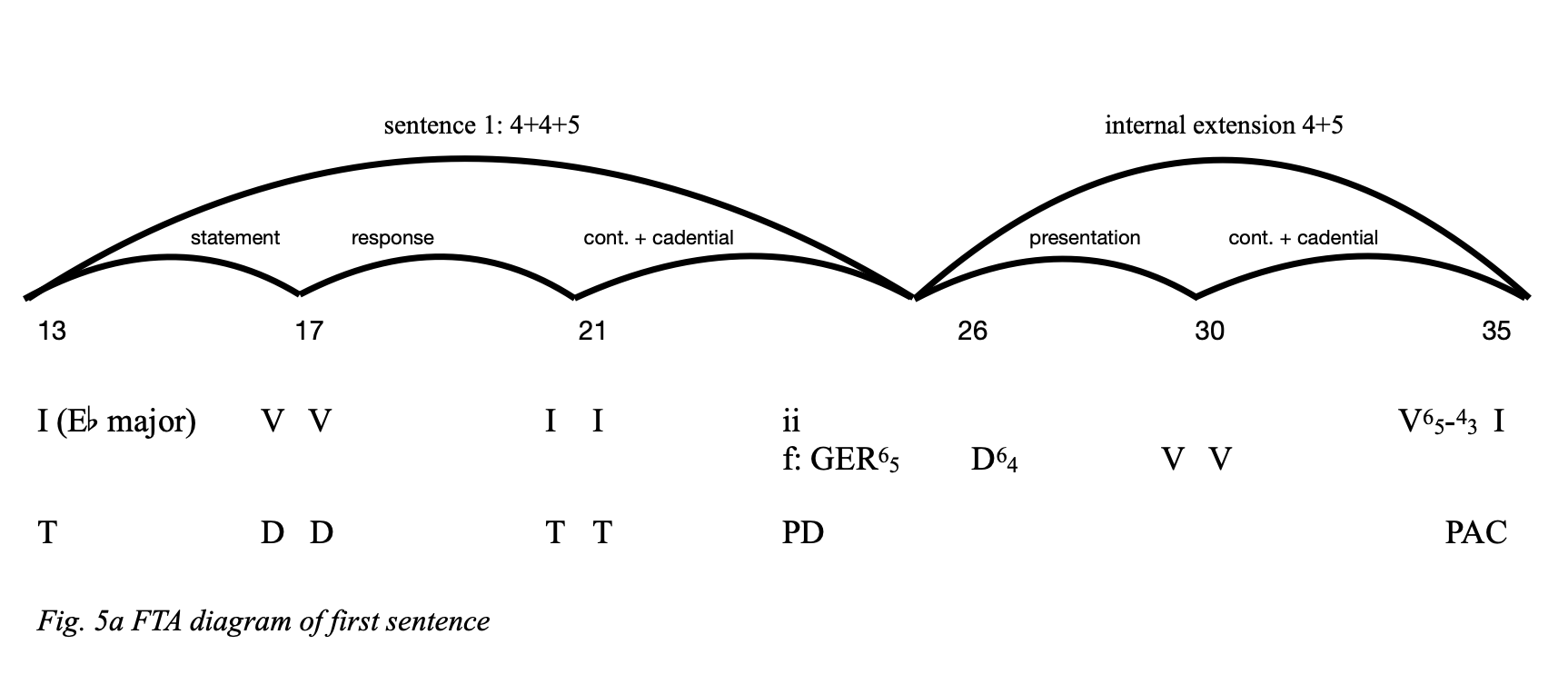
FTA: Second phrase (sentence)
M.35 is a bridging measure or an extension of the tonic chord that ends the previous phrase. The next phrase starts in m.36 and runs until the half cadence (HC) in mm.51-52. It is a 4+4+8 sentence, again one that respects the default ratios 1:1:2 of a sentence. Figure 6 shows a reduction of this sentence.

The basic idea (mm.36-40) starts with the main motive (variant of a1 and a3 [fig. 4]) in a lyric legato form in the cello. The key is again E-flat major. The accompaniment is in running quavers as shown in m.35 in figure 5. The reduction in figure 6 does not show these quavers but they are present in both hands of the piano part in mm.35-43 and then continue in the left hand of the piano until m.46. From m.47 until the end of the phrase they are again present in both hands. This is a major change in the texture and gives a feeling of anxiety to an otherwise lyric presentation of the main motive. One might call these two components the Florestan respectively the Eusebius character of this phrase.[4]Florestan and Eusebius are the fictional characters Schumann introduced in 1831 following the writer Jean Paul. They represent the turbulent respectively reflective side of the same person (Schumann himself). Schumann connected the words rasch respectively innig to them. For more information on the introduction of these characters, see for instance: John Daverio, Robert Schumann: Herald of a “New Poetic Age” (New York etc.: Oxford University Press, 1997), 74-75.
The repetition of the basic idea (mm.40-44) is played by the violin and one note higher. The key is f minor again and this type of repetition is called a sequential repetition. ‘The entire melodic and harmonic content is transposed to a different scale degree.’[5]Caplin, Classical Form, 39.
The key of the continuation (mm.44-52) is not evident. Initially I analysed it as being c minor but after comparison with the third phrase of the recapitulation (mm.237-252, fig.32), I changed that in g minor. The reason being that in the recapitulation it is more evident that the continuation starts in the iii of the local tonic (see the discussion there). Also the cadential progression in m.46 would be rather surprising if the passage would be seen as being in c minor. The key of g minor can be seen as the iii of E-flat making for a diatonic sequence in this sentence (I for the basic idea, ii for the sequential repetition and iii for the start of continuation). But g minor is also the relative minor of B-flat major, the dominant of E-flat and the key in which this sentence ends in m.52, a half cadence (HC).
One could say that Schumann did want to emphasise the relative minor (c minor) of the home key because of the twice occurring applied dominant of c minor (on the second beat of m.44 and the first half of m.45). Notice that in this way all minor scale degrees of E-flat major are passed in review: ii, f minor (the relative minor of the sub dominant), iii, g minor (the relative minor of the dominant) and vi, c minor (the relative minor of the tonic).
In m.48 Schumann makes a chromatic alteration by changing the E-flat to an E natural and adding a C#. Notice that the G and the B-flat stay; they are the common tones (C.T.) in this progression. The added C# is an interesting note. It resolves to the D in the next bar (m.49) as does the E to the F. But what is this chord in the first half of m.49? It is a B-flat 64 chord which is in its turn is a D64-suspension resolving to F7 in the second half of m.49. So indeed the C# leads to D but one step further is resolves to C in the F7 chord. Therefore the C# could (or perhaps should) be read as a D-flat which resolves by way to the D to C. Nice! So we are in a cadential progression to B-flat and after repeating this in m.50 the half cadence (HC) is reached.
Motives
In the continuation (mm.44-52) there is a motive in the right hand (a8) of the piano which resembles very much the motive a6 which is the motive of the continuation of the previous sentence (mm.21-26, fig.3). The rhythm is slightly changed possibly to continue the expression of the feeling of anxiety. This is much enforced by the diminution of the main motive in m.47 and m.51 which expresses it in semi quavers.
The complete legato phrase of motive a, starting with variant a7 in m.36 is a compound motive labeled x1. Figure 7 shows the motives of the FTA up to measure 47.

Figure 7a shows a diagram of the second sentence.
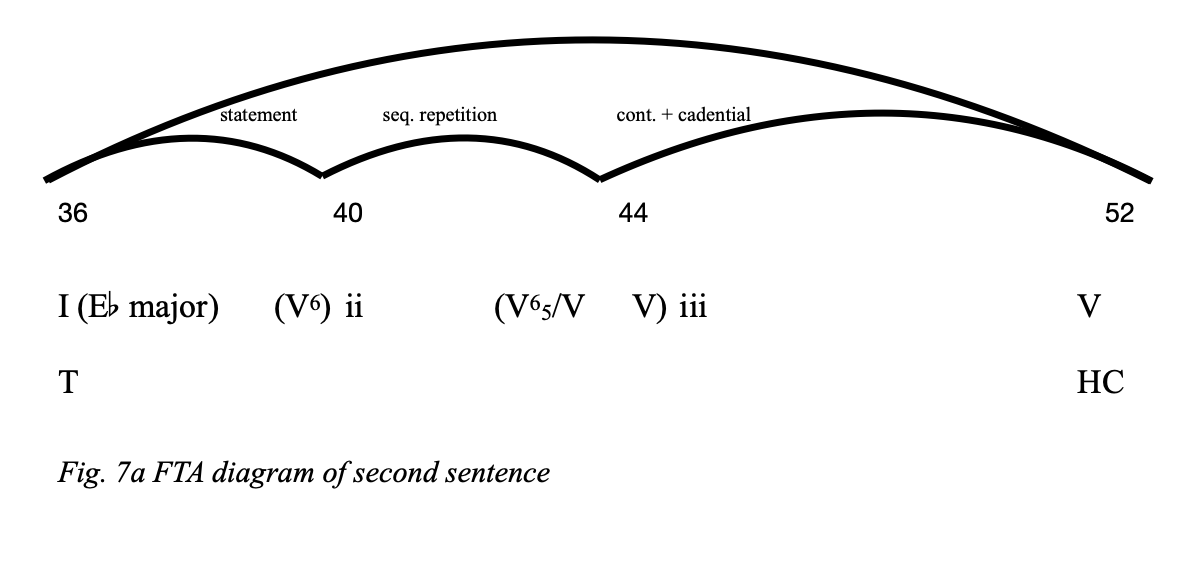
FTA: Third and last phrase (sentence)
As mentioned before the second sentence ends with a half cadence (HC) in mm.51-52 and the last phrase of the first tonal area (FTA) is about to begin on the second beat of m.52. As the transition starts on the second beat of m.64 (see table 1) this last phrase is 12 measures long and is in fact similar to the first sentence of the FTA (mm.13-25, fig.3). This time a 4+4+4 phrase. Comparing mm.52-56 with mm.13-17 we see that they are almost the same. The only difference is in the bass (cello): it is one octave lower. Figure 8 shows a reduction of the third sentence.

So the basic idea is the same and the first measure of the repetition of the basic idea also (m.56). But whereas in m.18 there is a I6 (E-flat) we find in the corresponding m.57 a e07 chord. This e07 chord is the viiº of f minor and indeed, in m.61 on the first beat we find this f minor (ii in E-flat major) chord. Looking at the continuation (mm.60-64) we find the same motive repeated thrice. It is a variant of motive a5, this time in a legato style and will be called motive a10. Harmonically the repetition of this motive is a sequential one: f minor – E-flat major – f minor or ii – I – ii. As ii is a predominant (PD) of E-flat, the last occurrence of the motive is a perfect upbeat to the perfect authentic cadence (PAC) which ends the FTA.
Motives overview of the first tonal area
Figure 9 shows all motives in the first tonal area (FTA). The variants of motive a can be grouped in three sets of motives. Within each group there are only differences in articulation and minor variants in rhythm. The three sets are:
- a1, a3, a7, a9
- a2, a5, a10
- a4, a6, a8
The three sets relate through mirroring:
- a2 = a1 mirrored horizontally
- a4 = a2 mirrowed horizontally and vertically

Figure 9a shows the diagram of the third and last sentence.
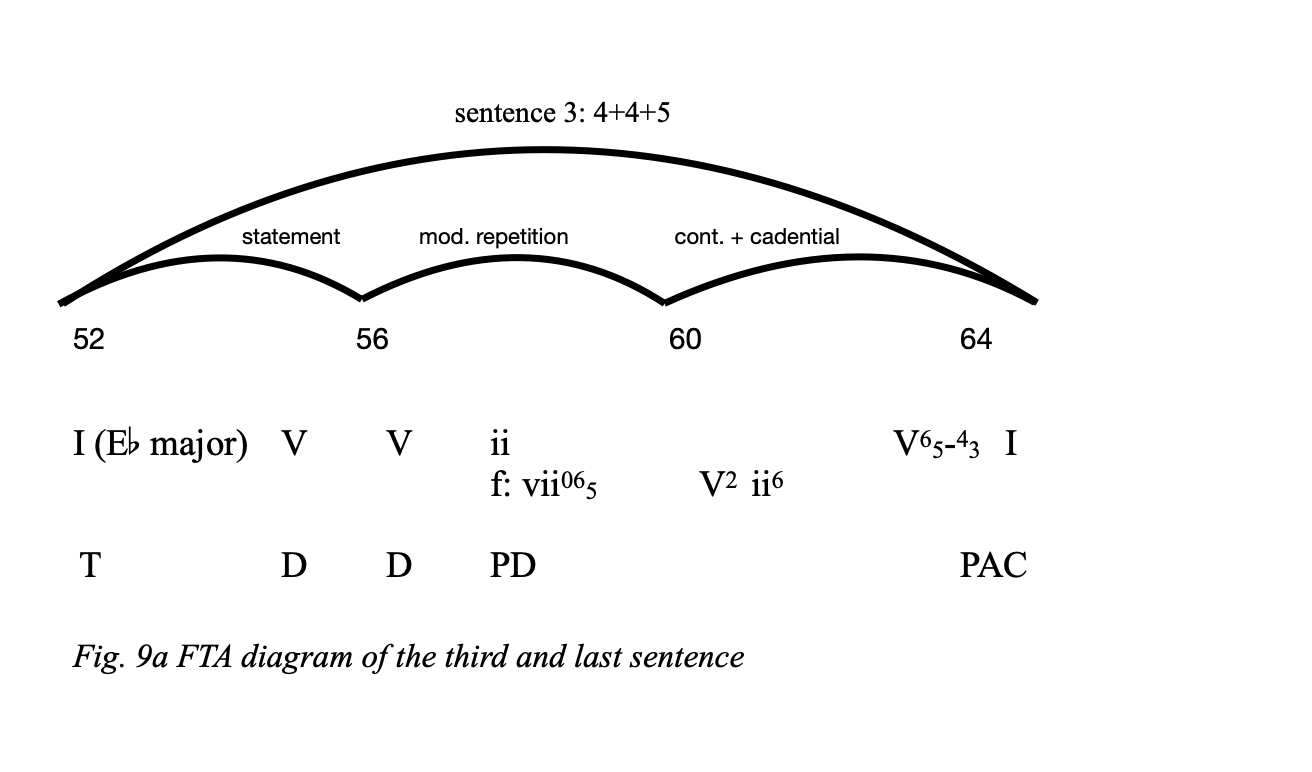
Form of the first tonal area
Looking back at the first tonal area, a ternary (ABA’) first theme group emerges. The first sentence, with extension, being the A part, the second sentence the B part and the last sentence, without the extension the A’ part. Generally the B part is supposed to be contrasting first of all because of the harmonies used. Looking back at the B part (fig.6) one can say that although the sentence starts in the home key, the repetition of the basic idea is in the supertonic and the continuation is in g minor, a key that may enjoy special attention of Schumann in this movement (see also the discussion on the second part of the exposition). And of course the texture of the B part is very different.
This concludes the analysis of the first tonal area or main theme.
The second part of the exposition
The title of this section already predicts its problematic nature. As mentioned in the overview we are in fact looking at a section that is positioned as a transition of which we expect that it will lead to a second theme group or a second tonal area (STA). In the paragraph about the global structure a conclusion was drawn that no second tonal area or second theme group can be found. Let’s investigate if this is tenable.
Exposition second part: First phrase (sentence with repeated presentation)
Figure 13 shows a reduction of mm.64-80. In a moment it will become clear why this particular cutout has been made.
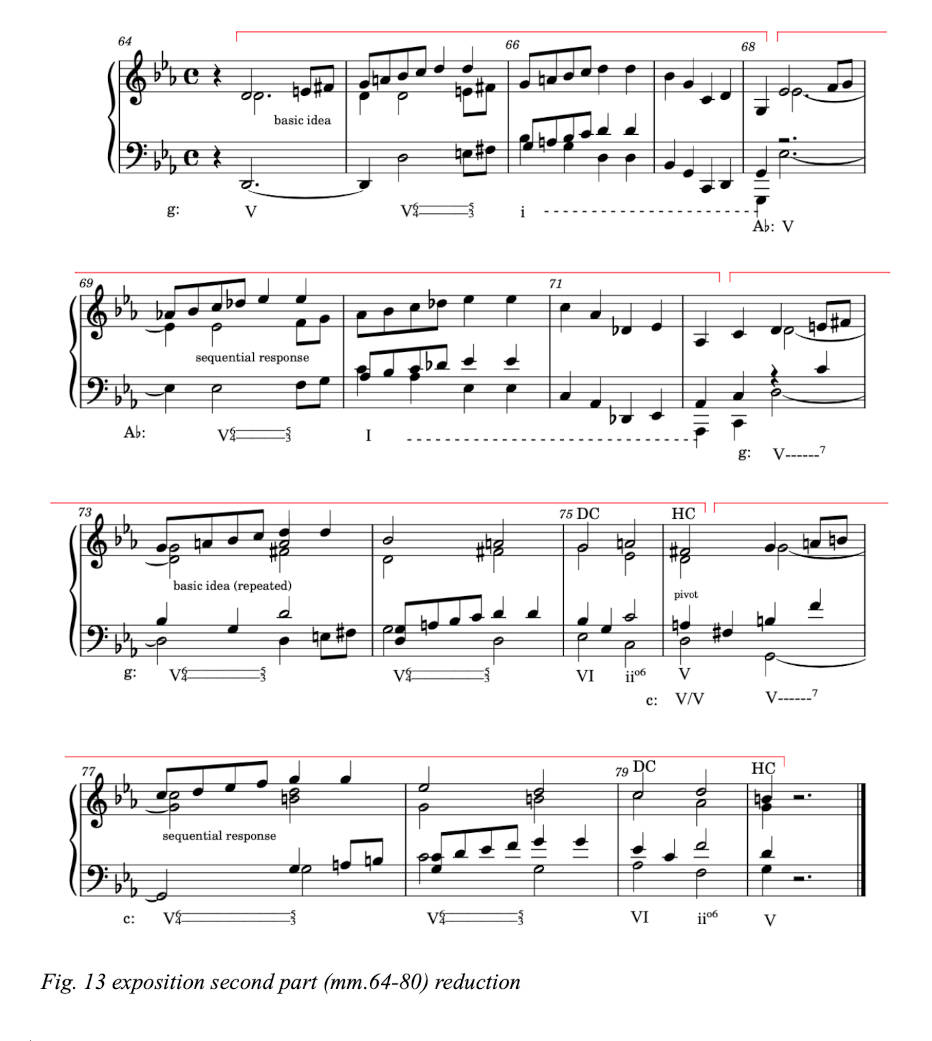
Starting at the second beat of m.64 we find the ascending scale motive in an imitative style (first the piano and then the strings) starting on the harmony of D major and ending in g minor (mm.66-67). The D major is of course a surprise in the E-flat major context, but turnes out to be the applied dominant of g minor. The first beat of m.68 is clearly an end point in the phrase so we have a four bar phrase (m.64 second beat to m.68 first beat). The key is g minor, as mentioned earlier the mediant of E-flat major. This phrase is immediately repeated but one semitone higher in the key of A-flat major, a sequential repetition.
The motive and the harmonic structure are exactly the same. As we have seen a number of sentences in the first tonal area, we might expect another sentence of which the basic idea is four bars long and the repetition then of course also. If this were to be a sentence then what follows would logically be a continuation of (with straight forward reasoning) eight bars.
However this is not the case. Looking at the next four bars (m.72 second beat – m.76 first beat) we find the same phrase, this time only played by the piano (not visible in the reduction). The harmonic progression is different: the phrase starts the same in D major being the dominant of g minor but ends with a deceptive cadence on VI (E-flat major) in m.75. This is followed by a ii06 (a diminished chord on A), a predominant in g minor and then in the first half of m.76 a D major chord (the dominant of g minor). As this is the end of the four bar phrase it can be read as a half cadence (HC) but at the same time the D major chord is the dominant of G major (m.76 second half) which in its turn is the dominant of c minor. So the first half of m.76 has a double function: a pivot chord.
In the mean time we reached the next four bar phrase (m.76 second beat – m.80 first beat). It is again the same motive, this time in c minor, with the same harmonic progression as the previous phrase. In m.79 we find the deceptive cadence, then again the half cadence in c minor (m.79 second half: predominant ii06, m.80 first beat: dominant G major chord). In the same way as the D major chord in m.76 before this G major chord can also be reinterpreted as the dominant of the dominant (C major) of F major.
From this point onwards there is not another four bar phrase but an eight bar phrase (m.80 second beat – m.88 first beat). This is in fact the eight bar phrase we expected at m.72 after the two four bar phrases which could be interpreted as the presentation of a sentence. Figure 14 shows the reduction of these eight measures.
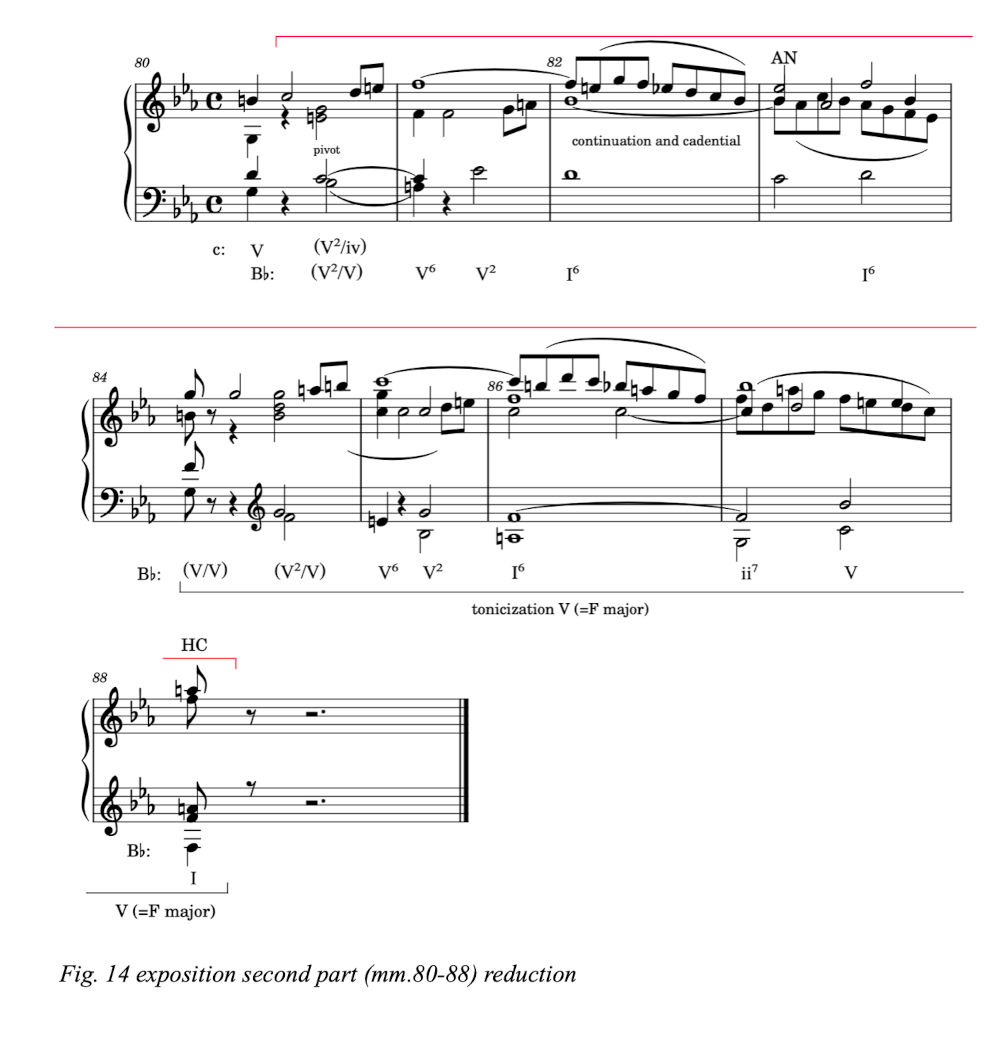
The motive played by the violin is cut short after three ascending steps (m.81) and an ornament follows (m.82). In the piano follows the imitation in m.81.
Harmonically this eight bar phrase starts again with a dominant (here C major in the second half of m.80) proceeds to F major and then touches on B-flat (first inversion, mm.82-83) followed by a cadence in F major.
Notice that the whole phrase is analysed in B-flat major which is indeed the dominant of the home key E-flat major and as mentioned in the paragraph about the global structure this dominant key has for historic reasons a special meaning.
If we take a step back and look at the whole passage from m.64 to m.88 then we have first two times four bars which are very similar but differ one semitone in key (g minor and A-flat major). This is the presentation of a sentence with a basic idea and a sequential repetition. Then what follows is another phrase of two times four bars (mm.72-80). Both groups of four bars have the same structure in harmonic progression and the same motive. So again a basic idea with a sequential repetition but this time with a falling fifth progression. In fact this is a repetition of the presentation of mm.64-72 with the same motive but a different harmonic progression.
After this the continuation of the sentence follows (mm.80-88). The falling fifth progression is continued and brings us for a short moment to B-flat major only to stabilize on F major. Analyzing the following phrase (mm.88-103) we will see that this will start in B-flat major. That is the reason the continuation of the present sentence is analysed in B-flat and that it ends in a half cadence (HC): F major, the dominant of B-flat major.
Motives
Before showing the diagram of the complete sentence (fig.15) we have to look at the motives that Schumann uses here. Figure 14a gives the overview.
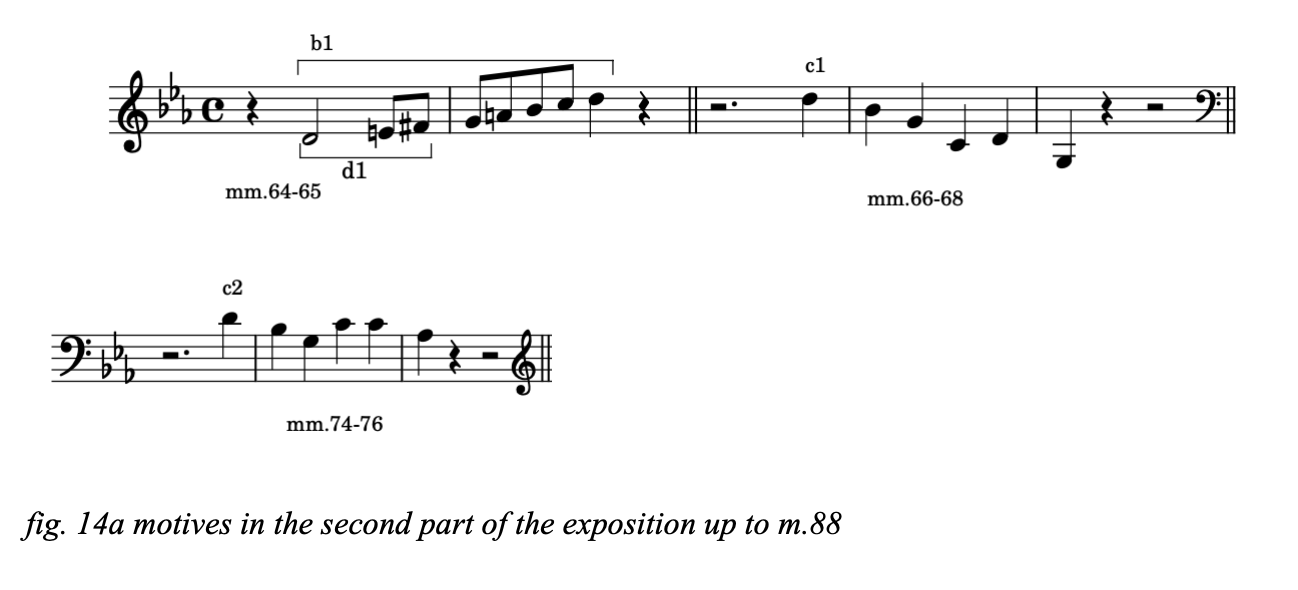
The first half of the basic idea of the sentence (mm.64-68) is motive b1, the ascending scale motive. In this motive another, smaller motive can be distinguished: d1. As will be shown later on a variant of this motive is used. The second half of the basic idea is motive c1, a descending triad (here in g minor) with the appoggiatura on the third beat and the cadential leap down at the end. This motive has some variants, depending on the harmony the phrase is aiming for. So motive c2 is a variant that ends on the dominant and not on the tonic as c1 does. Also the leap downwards of a fifth is changed in a leap up of a fourth, both ending on the same scale degree.
In m.80 motive d1 is used (in another key) but it is not followed by the rest of the scale. It stays on the fourth scale degree (in this case the F natural) for a whole bar in which the imitation starts in another voice. Then an ornament follows that ends with a leap to the fourth scale degree (m.83).
Figure 15 shows a diagram of the whole passage.
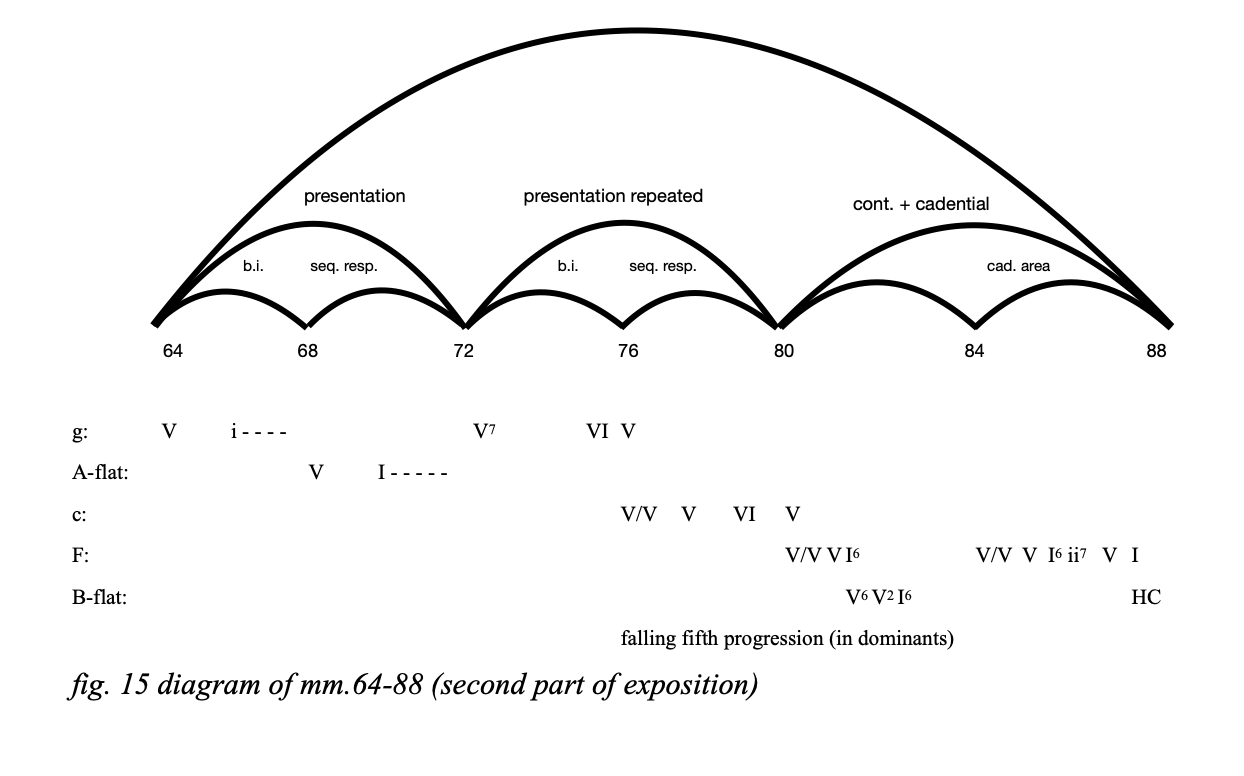
The falling fifth progression starting in m.76 is clearly visible. In this diagram the key of F major has been included whereas in the reduction (fig. 14) this is analyzed as the dominant of B-flat major (with a tonicization in mm.84-88). The reason that fig. 15 includes F major is to clearly show the falling fifth progression (g minor – c minor – F major – B-flat major).
Time line metaphor
At this point I would like to cite three quotes of Robert Schumann himself. The first one is from an editorial of the New Year’s issue of the Neue Zeitschrift für Musik of 1835, of which he had recently become the sole editor:
In the short period of our activity, we have acquired a good deal of experience. Our fundamental attitude was established at the outset. It is simple, and runs as follows: to acknowledge the past and its creations, and to draw attention to the fact that new artistic beauties can only be strengthened by such a pure source; next to oppose the recent past as an inartistic period, which has only a notable increase in mechanical dexterity to show for itself; and finally, to prepare for and facilitate the advent of a fresh, poetic future.[6]this quote is cited from: Daverio, Robert Schumann, 119.
In his Heidelberg period (1828-1830) Schumann had developed a view on history and more specific on music history. In this view the (pure and beautiful) past is a source of inspiration for the present. The recent past is imperfect to say the least but in fact Schumann and a couple of his friends had created a group called Der Davidsbündler “a band of crusaders against philistinism in contemporary music”.[7]Daverio, Robert Schumann, 113. So his feelings about the imperfection of his contemporaries were pretty strong. Schumann’s view on music history was completed by a future that is fresh and poetic and does not have the shortcomings of the present and recent past.
The second quote is from an earlier date, 16 August 1828:
Love the past, act in the present and fear the future. In this way a beautiful harmony, a powerful triad comes into being.[8]cited from: Daverio, Robert Schumann, 119.
So here an association is made between Schumann’s threefold epochs in time and the triad as basic building block of western classical music.
And finally in 1834 Schumann lets Eusebius say:
Triad=[historical] epochs. The [interval of a] third, as present mediates the past and the future.[9] cited from: Daverio, Robert Schumann, 119.
Here the association is made more explicite and leaves little room for imagination.
When we consider the first movement of the piano quartet up to the point the analysis has been made then the exposition starts with a pretty elaborate first tonal area which is firmly-rooted in the home key E-flat major which according to the mentioned quotes stands for the past. Then the second part of the exposition begins in g minor (m.64), the third (or mediant) of E-flat major and can be seen as mediating between the past and the future. According to the last quote the fifth (or dominant, being B-flat major) stands for the future which will indeed be reached in the second part of the exposition. As has been shown Schumann connects the third with the fifth of E-flat major by means of a descending fifth progression.
Exposition second part: Second phrase (sentence)
This phrase turns out to be again a 4+4+8 sentence. Figure 16 shows the reduction.
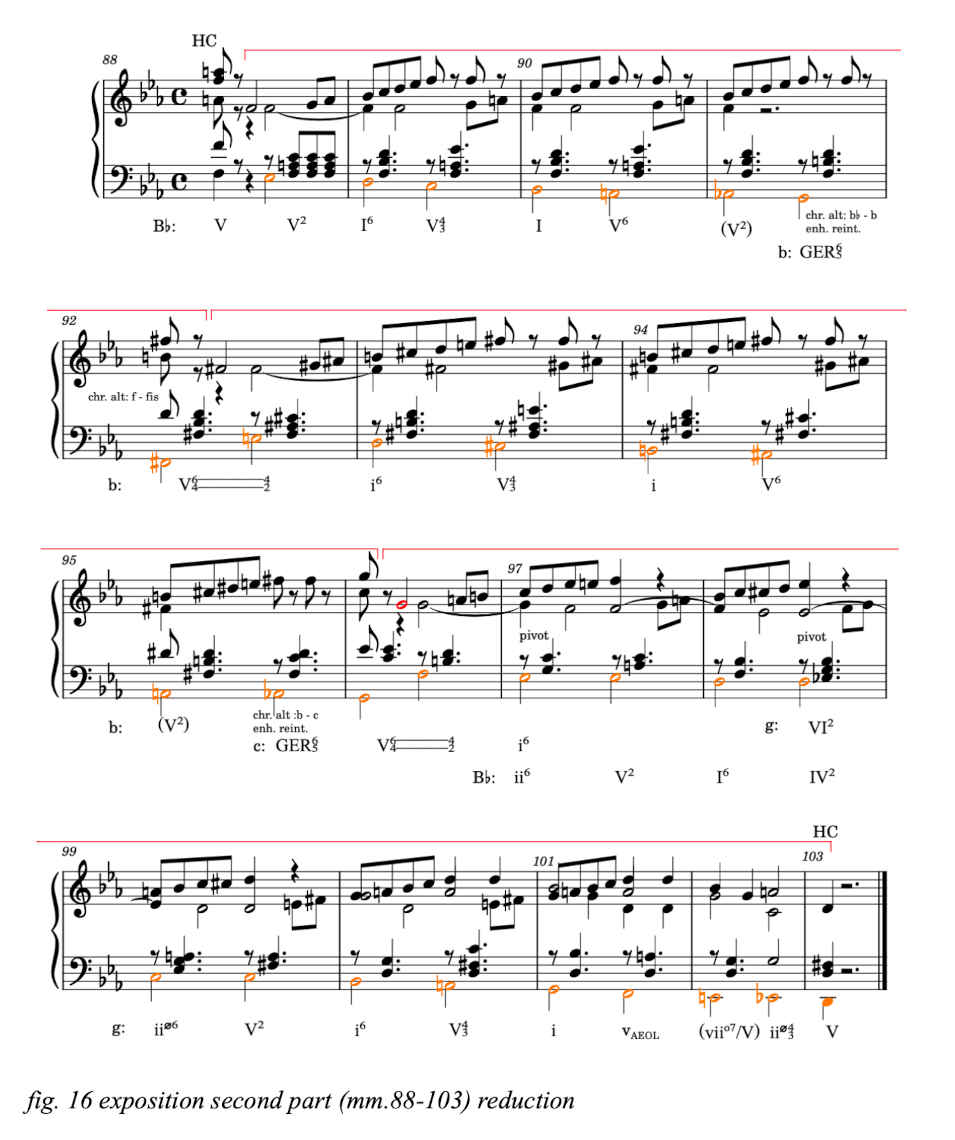
The end of the previous phrase on the first beat of m.88 has been indicated as a half cadence (HC) in B-flat major. After that F major chord there is an eight rest in all voices, except the cello, and after that we do expect B-flat. And the B-flat is indeed found but only after a diatonic descent in the bass from the 5th scale degree (F) to the first scale degree (B-flat). This is reached in m.90. I think the descending bass line is clearly an underlying principle in this sentence. Notice also the repeated quavers in the left hand of the piano. In the reduction of fig.16 they are only shown in m.88 but they continue throughout the sentence. They give the same type of unrest and agitation as in m.35 (fig.5) and the whole following sentence shown in figure 6 (quavers not shown).
The descending bass line is continued in m.91 but now chromatically. Here a modulation to b minor is being made. So we go up one semitone. The modulation takes place on the second half of m.91 where Schumann continuous the chromatic descent in the bass (A-flat to G) and makes a chromatic alteration (B-flat to B). F and D are the common tones in this progression. The resulting chord can be enharmonically reinterpreted as an augmented sixth chord in b minor: a GER65 chord. Therefore the F natural should be read as E-sharp (the raised 4th scale degree of b minor). As we have seen before this chord has a double leading tone to the 5th scale degree of b minor – F-sharp – being the dominant of b minor. Thus the leading tones are G and E-sharp, the last one in the score being written as F natural. Again the GER65 chord has a predominant function and in m.92 the dominant sixth-four chord (written as V64) follows on the first beat of m.92 and here ends the four bar basic idea of this sentence. The motives used are the b1 and c1 motive in a canonic way.
The sequential repetition beginning on the second beat of m. 92. starts again (as in m.88) on the dominant chord in third inversion (V42). In m.93 the tonic of b minor is reached in first inversion and a V43-i progression takes it to the root position. This is exactly the same as in mm.89-90.
Notice that in m.92 the bass leaps up a major seventh, but in fact this is the first step in another diatonically descending bass line, but transposed one octave up to keep the notes in an attainable register.
The response (m.92 second beat to m.96 first beat) is indeed an exact repetition of the basic idea but this time in b minor. It leads to c minor in the second bar of the continuation (m.97).
In an accelerated harmonic progression Schumann modulates in four bars to g minor by way of B-flat major. The modulation is this time made by means of pivot chords and not through the use of chromatic alterations as were used in the presentation of the sentence.
The i6-V43-i progression in mm.100-101 is the same as in the basic idea and repetition. Notice that the descending bass line is continuous here for eight measures without an octave jump and encompasses a tenth. The progression is slowed down to half the speed in mm.97-99, funny enough in the bars where the harmonic rhythm is speeded up. A very nice contrast!
Schumann uses a slightly varied version of the b1 motive, the most important change being that it spans a seventh and not an octave. This variant is called b2. Once we are safe and sound in g minor (m.99 second half) the b1 motive returns with the second time again a slightly different version of the c motive (c3) to support the ending of the half cadence (HC) in g minor. This concludes the analysis of this sentence. If you have come this far reading the analysis you surely will succeed in drawing the diagram of this sentence yourself.
Motives
Figure 17 shows the motives in the second part of the exposition up to m.103.
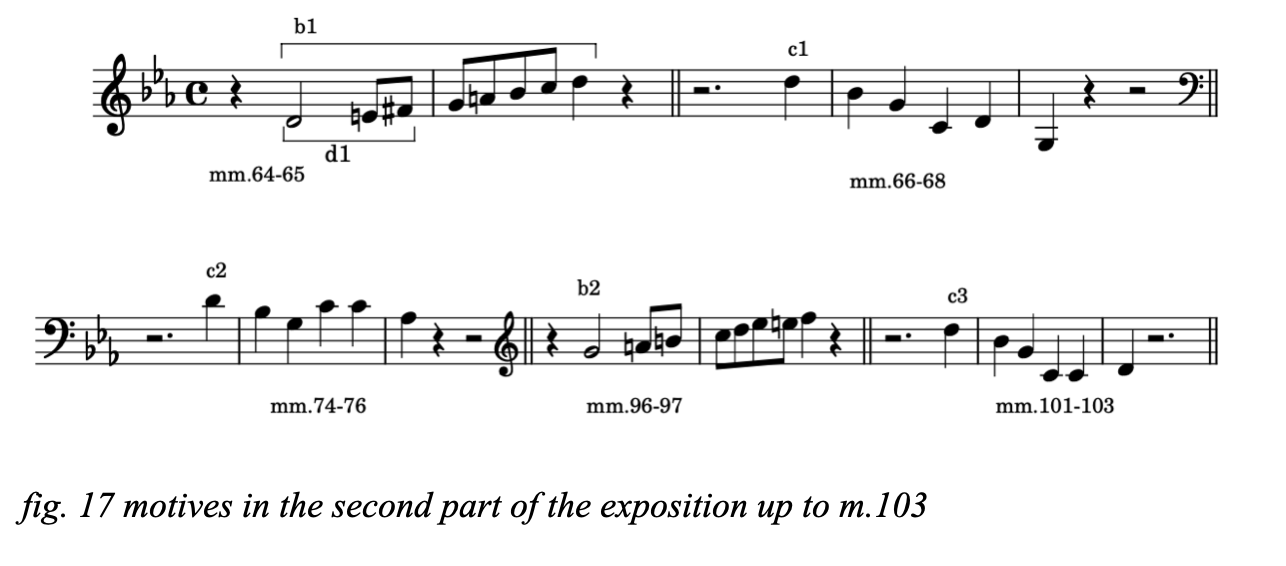
Exposition second part: final phrase
Figure 18 shows the reduction of the final phrase of the exposition.
Now this is quite a surprise. First of all the motive that has been ever present in the second part of the exposition occurs only twice (mm.107-110). This time the key is e-flat minor, the ivMD of B-flat major and thus a predominant of this key.

As shown in fig. 18 this is followed by an augmented version b3 of the b motive in the alto (also in the original score) which modulates to the first inversion of the Neapolitan chord C-flat major in m.113. This chord also has a predominant function (both the E-flat and G-flat pulling toward the F natural, the dominant of B-flat major). From m.115 onwards there is a twice repeated dominant seventh chord (m.116 and m.117) both preceded by the V64 suspension leading to the perfect authentic cadence (PAC) in mm.118-119. Notice that the tonic chord is very empty. Just B-flat on the first beat of m.119 with the third added on the third beat. Still not a full bodied chord. Looking at the last measures (mm.121-124) of this reduction the reason becomes clear: the B-flat turns immediately into the dominant of E-flat major, the key of the introduction of the development.
So after all this wandering about the dominant of E-flat major (B-flat) is reached but too late to be the key for the subordinary theme or second tonal area (STA). Nevertheless its function in this place is quite normal: the closing of the exposition and at the same time the dominant for the things to come.
Before reconsidering the second part of the exposition we have to look at mm.103-107, the beginning of this phrase.
In the reduction in fig.18 the end of the previous phrase is shown on the first beat of m.103. It is the end of a half cadence (HC) in g minor (D major). This is a back related dominant (BRD), which means that it belongs to the previous phrase and does not have a function in relation to the phrase to come. Notice that the fifth is missing in this chord.
On the second beat also the third is left out and we are left with just a D natural. This is used as the start of a chromatic progression towards F natural which turns out to be the dominant of B-flat major which appears on the first beat of m.105 after a cadential progression (m.104). Again with only the third in the chord. The chromatic progression in m.103 is a variant of motive d1 and will be called d2.
In m.105 the procedure is repeated. On the second beat the open F natural returns (a connection with the first beat of m.104) and a chromatic progression follows, this time to A natural which turns out to be the dominant of d minor. The d minor chord appears on the first beat of m.107. With respect to the start of the predominant section in m.108 it can be seen as a pre-predominant harmony. Of course it is also the mediant of B-flat major and as we have seen, Schumann did give the mediant a special meaning (find the quotations here).
Motives overview of the second part of the exposition
Figure 19 shows all variants of the motives b, c and d of the second part of the exposition.

Reconsideration of the second part of the exposition
The detailed analysis of the second part of the exposition is done. In the paragraph on the global structure the conclusion was drawn that the second part of the exposition is a transition to the development without any further subdivision. As has been shown one can distinguish three phrases as follows:
mm.
64-88
88-103
103-120
phrase of exposition part 2
first phrase (sentence with repeated presentation)
second phrase (sentence)
third phrase (mainly cadential progression)
Taking into consideration that Schumann studied intensely the string quartets of Haydn and Mozart in January of the chamber music year (1842)[10]Daverio, Robert Schumann, 249., I think it is legitimate to ask whether this subdivision can be mapped onto components of the sonata form. In what follows I rely heavily on the discussion in the chapters three and four of the book of James Hepokoski and Warren Darcy on the medial caesura and the two-part respectively continuous exposition.[11]Hepokoski, James A, and Warren Darcy. Elements of Sonata Theory: Norms, Types, and Deformations in the Late-Eighteenth-Century Sonata (New York [etc.]: Oxford University Press, 2006).
The generally agreed upon components of the sonata form exposition are as follows:
- first tonal area or primary-theme zone
- transition
- medial caesura
- second tonal area or secondary-theme zone or subordinate theme
- perfect authentic cadence (PAC) in the secondary key also called Essential Expositional Closing.
- closing section
More information on Essential Expositional Closing can be found in Hepokoski and Darcy. Elements of Sonata Theory, p.18.
The first tonal area has a clear structure in Schumann’s piano quartet (mm.13-64 first beat) and there is no discussion where it ends.
I think that the first phrase of the second part of the exposition[12]This is not “the second part of the exposition” according to Hepokoski and Darcy because in their theory there is no second part of the exposition in this composition, which would be the subordinate theme and an optional closing section. (fig.15) has characteristics of a transition. Starting with the new b-motive in the mediant (g minor) it modulates to F major and after a cadential progression it ends on a half cadence (HC) in B-flat major on the first beat of m.88. This is a very classical procedure: modulating to the HC of the dominant of the home key. In the classical style in major keys the key of the second tonal area is by default the dominant (in this case B-flat major).
Furthermore the first beat of m.88 (fig.16) can be seen as a medial caesura with a caesura fill in the cello. In my post general notes on analysis these concepts are explained.
So these features point in the direction of a transition. What is not classical about this transition is that it fails to gain energy towards the medial caesura. Hepokoski and Darcy call this a de-energizing transition.[13]Hepokoski and Darcy. Elements of Sonata Theory, 44.
But then what? The medial caesura is articulated and the second sentence starts (m.88 second beat, fig.16) but we can hardly call this a secondary theme. The b-motive continues unabated. It looks like Schumann is elaborating on this motive which only calms down in the perfect authentic cadence (PAC) in B-flat major in m.119. And this PAC is in fact the only place that qualifies for the (harmonic) closure of the exposition, the Essential Expositional Closing (EEC) in the terminology of Hepokoski and Darcy. No closing section to be found; only the bridge to the slow introduction remains (mm.121-122), which is the beginning of the development.
So I conclude that Schumann treats us on a Haydn-like continuous exposition with no secondary-theme zone and no closing section. He keeps us in tention about the key we are into. Is it g minor or B-flat major? In the end it turns out to be B-flat major, but not very convincingly, because of the hollow chords and the immediate transition to the development in E-flat major.
The third phrase is – as has been stated – mainly a cadential area towards the EEC which is rhetorically emphasized with the augmented b3 variant of the b-motive (mm.111-114).
This concludes the analysis of the exposition.
Development
Table 2 shows the layout of the development section. All segments will be discussed separately.
Measure
123-136
136-149
149-165
165-181
181-189
189-203
204-212
Segment
slow introduction
Key
E-flat – D64/d
d – g
a – b – b – e
C – c#
d – g
f – a-flat minor
E-flat: V9-7
Comment
like mm.13-26
motive a3 & x2
motive a7
variant of motive a7
motive a6 & a7
motive a8 and variant
Table 2: layout of the development
The slow introduction of the development
The first thing to notice is that the slow introduction does not start in m.125 at the double bar line (the Sostenuto) but two bars earlier in m.123. The comparison of mm.1-2 and mm.123-125 as shown in fig.20 makes this clear.

When comparing the two passages one sees that mm.123-124 is an augmented version of m.1, but mm.123-124 are in alla breve time so the effect is the same as in m.1. In fact it is a matter of notation. As shown in fig.20 m.125 is in common time and should fit nicely with mm.123-124 in alla breve time.
The rest of the introduction of the development (mm.125-136 first beat) is very much a copy of the slow introduction at the beginning of the movement (fig.1). The only difference is that it leads to the key of d minor. This is done in the last two bars (mm.134-135) as shown in fig.21. Measure 133 is the same as m.10. The modulation is made by reinterpreting the dominant seventh chord (B-flat) as an augmented sixth chord in d minor (GER65). Schumann skips the dominant and proceeds immediately from the suspension i64 to the tonic.

Development: Segment 1
Figure 22 shows the reduction of this segment.
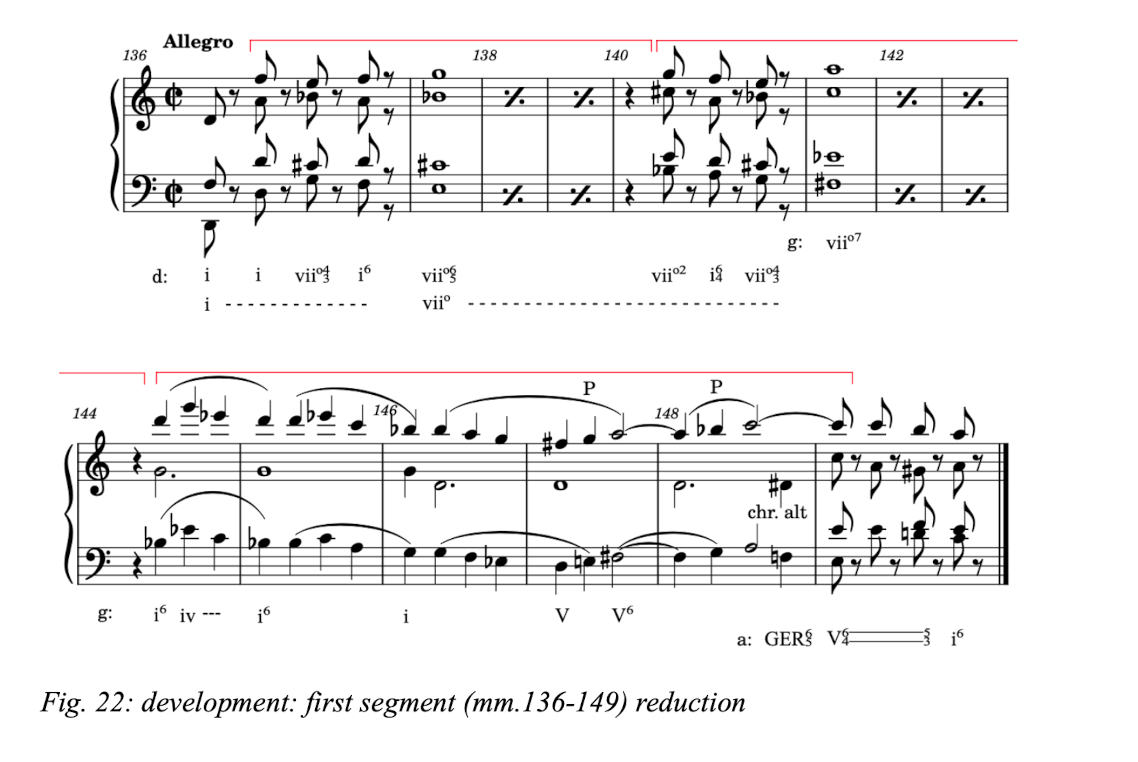
The development starts (after the slow introduction) with a phrase that resembles very much the first phrase of the exposition (fig.3). It is the same 4+4+5 sentence like construction. The harmony however is different. Whereas in the exposition there is a statement-response presentation, here Schumann uses a sequential repetition of the basic idea. The basic idea (mm.136 second beat-140 first beat) ends on the diminished vii of d, the repetition ends up on the diminished vii of g minor. You could say that this is the inverse of a statement-response construction because d minor is the aeolian dominant of g minor.
What connection does Schumann use here? One explanation could be as follows: the vii0 of d makes us expect d (or D) but what appears is a vii0 of g minor (m.141). But the vii07 of g minor can be seen as a dominant of g minor without the root of the chord (the D). And the dominant of g minor is D major. So the vii07 of g minor leads in fact to a D chord, but one without the root of the chord.
Another way to look at this is to see the vii07 of g minor (m.141) as a chromatic shift down of the whole diminished seventh chord with a semitone and then read it in another inversion (from a vii043 in d minor to a vii07 in g minor). Quite a nice harmonic progression!
Development: Segment 2
Here we enter the core of the development where two motives are sequenced. Figure 23 shows the reduction.
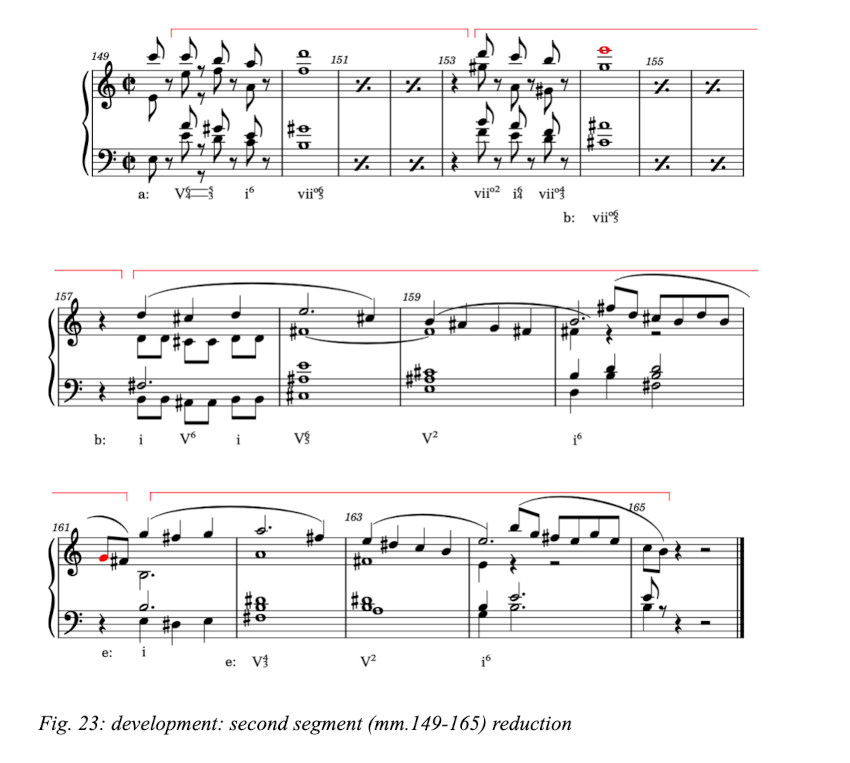
This segment starts with the a5 motive in a minor and is then repeated in b minor. This is followed by a variant of motive x1 (called x2, fig.29) presented in the basic idea of the second sentence of the first tonal area (fig.6). The phrase starts with motive a7 but has a variation of the closing thrill (m.160) which is the end of the ornamentation in the piano as for instance in mm.152-153. The key is b minor also and then the phrase is repeated in e minor. So we have a (4+4)+(4+4) sequential structure.
Why is this not a 4+4+8 sentence? Because the part that should be the continuation (mm.157-165) does not have the characteristics of a continuation. There are no signs of fragmentation: as mentioned the phrase is restated. As for a cadential closure related to the “presentation” of the sentence: there is none. No accelerated harmonic rhythm and the first inversion of e minor is not a half cadence for a minor. So no sentence but sequences.
Looking at the connection between the vii043 of a minor in m.153 and the vii065 of b minor in m.154: it is again a chromatic shift down of the chord by a semitone. This time however the interpretation mentioned in the discussion of the first segment is not possible because Schumann takes another exit. He moves to b minor (m.157) so the chord in m.154 should be spelled as a#07 or a F# dominant 9 chord without the root. And this is not what we expect after a vii043 of a minor; after this chord we expect a minor or A major and Schumann should have taken the exit to d minor or D major, but he didn’t. The question why he did chose b minor is an intriguing one. If you have any idea, please let me know (in the comment box at the end of this post).
Development: Segment 3
Now that we have warmed up a bit on sequencing look at what comes next. Segment 3 is a two times 8 bar chromatic semitone sequence and within that a threefold whole tone sequence. Figure 24 shows the reduction.
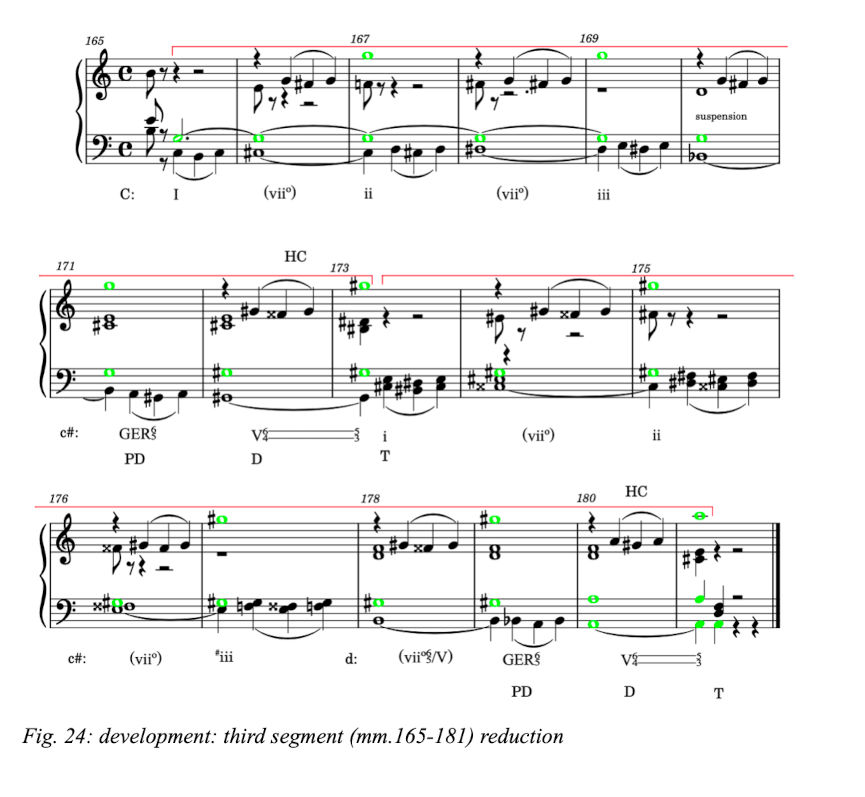
The two phrases of eight bars each are m.165 second beat – m.173 first beat and m.173 second beat – m.181 first beat in which the harmonic progression is quite similar but there are a few differences which I will point out shortly.
The first phrase is in C major and the second in c-sharp minor. Notice the pedal on the dominant in each phrase. It has been made green. So this is a chromatic ascending sequence of a minor second. The modulation from C major to c-sharp minor is made in mm.171-173. The harmony in m.171 is written as an A dominant seventh chord (which suggests D major or minor). But what follows is the dominant of c-sharp minor. So there is a need for another interpretation of the harmony in m.171 and therefore we read the G as a F-double-sharp, which is the raised fourth scale degree of c-sharp minor. The harmony can thus be read as an augmented sixth chord, a GER65 in c-sharp minor, and its function is predominant. Indeed, what follows is a V64 suspension and the dominant of c-sharp minor and the tonic is reached on the second beat of m.173.
Within each phrase there is a ascending sequence of a major second. Each step is preceded by the diminished seventh of the chord to come. Measure 165 second beat is the tonic of C major. Measure 167 is the next step, a major second higher, d minor, the ii of C major. Measure 166 is a c#0 chord, the vii0 of d minor. This is repeated once more and in m.169 the third scale degree with its harmony is reached: e minor.
This procedure is repeated from m.173 onwards, but then of course in c-sharp minor. Notice the e-sharp minor chord in m.177 (with the e-sharp notated as a f natural). This is not a diatonic progression (which would be an e natural in c-sharp minor). But it fits with the d-double sharp diminished chord (notated as an e diminished chord)[14]Schumann is not very consistent is his notation here. The piano has a F-double sharp in the right hand which belongs to a d-double sharp diminished chord. The viola has a G natural, which is enharmonically the same note as the F-double sharp but belongs to an e diminished chord. As the current key is c-sharp minor the d-double sharp variant is more fitting. in m.176 which is the vii0 of the e-sharp chord and makes for a consistent major second progression.
The modulation set in at the end of the second phrase leads to d minor.
So this segment consists of a chromatic sequence of 8+8 bars of a semitone and within that a sequence of a whole tone which is only nearly diatonic. Nested sequences! I love it.
And now for another difference in the two phrases. Compare m.170 and m.178. The harmony of m.170 is g minor, the harmony of m.178 is g-sharp diminished. This last harmony can be interpreted as the diminished seventh chord of A major. A major is the dominant of d minor which is the aim of the modulation. So a pretty clear harmonic function. But m.170 is not a diminished but a g minor chord. Would it have been a g diminished chord (d-flat in stead of d natural) it would have been a congruous function with the harmony in m.178: the diminished seventh chord of G-sharp major, the dominant of c-sharp minor. But it is not. So the interpretation of the harmony in m. 170 must be a suspension for the GER65 in m.171. Of course one can reason the other way around: why is there a d natural in m.178 and not a d-sharp, fitting in the harmony of c-sharp minor? Another intriguing question. Any suggestions are welcome in the comment box at the end of the this post.
Last but not least: the motive being used throughout this segment is the a7 motive (fig.9) which is repeated every bar (sixteen times). Comparing this with the motivic material in the previous segment it is clear that the fragmentation has started.
Development: Segment 4
And again a reduction (fig.25). Measure 180 has been added to show the half cadence and the connection with the new start in the current tonic (d minor, second beat of m.181). The segment itself is from m.181 second beat to m.189 first beat.

In fact we have the same harmonic and motivic structure as in the previous segment: an overall progression from d minor to g minor and within that a progression of a second, and this time it is diatonic again. Here also the steps in the sequence are preceded by there applied seventh diminished chord. In m.182 it is a d#0 chord, the vii0 of e minor (the ii of d minor). Notice that as in the previous segment the chords are most of the time not complete. Only when the pedal fits in the harmony there is a complete chord as is the case in m.182 where the pedal note A fits in the d#0 chord. You could say that Schumann only suggests the chords and you have to complete them in your head (ears) according to the context.
In m.184 there is also a diminished chord (g#0, not complete again), but this is not the vii0 of F major chord in m.185. It is the vii0 of a (minor), so this is a deceptive progression as F major is the VI of a minor.
Why is this and what is the analogy with mm.176-177 in the previous segment (fig.24)?
Well, the keys are both minor: c# minor in mm.176-177 and d minor in mm.184-185. And the fact is that in minor keys the chord on the second scale degree (ii0) is a diminished one. For instance in d minor this chord is e diminished. As has been observed the chords are most of the time not complete so in m.183 the chord could be an e minor or an e diminished chord.
Now the ii0 in a minor key is also the vii0 of the chord on the third scale degree (III). If Schumann had in mind to make a diatonic progression (within a larger frame as we have seen in the analysis of the third segment) with each step preceded by its own applied vii0, then in minor keys there is a problem because the ii0 in the progression is the vii0 of the III and the symmetry would be lost because he would have to double a chord in the progression or he would need to leave one bar out.
He chose another solution, in fact two other solutions. In mm.176-177 he did not proceed to the III of c#-minor (which would have been E major) but he proceeded to e-sharp minor (#iii) which he could give its own applied vii0 (d-double sharp diminished, m.176). In mm.184-185 he did proceed to the III of d minor (F major) but he treated it as the VI of a minor to be able to give it the applied vii0 of a minor (g#0) and make the progression deceptive. That is how he got round the problem that the ii0 of d minor is the vii0 of the III of d minor. Are you still with me? I hope so.
In the second half of this segment, Schumann uses the same construction one last time in g minor (mm.188-189) and the same solution as in mm.184-185: the deceptive progression.
Perhaps a last remark about why I made mm.181-189 a new segment and did not merge it with segment 3 as one big segment. The reason is the texture of the music. You’ll need to look in your score to see that. Measure 181 is forte after a crescendo from m.177 onwards. The a7 motive is here played in quavers in the viola, a new variant of the a motive which increases the unrest and tension. The long notes of the previous segment are divided in quarter notes (in the violin and the cello) which gives much more emphasis and adds to the tension. And last but not least there are the incomplete triplets in the right hand of the piano, equally adding to the rambunctious character of this phrase which ends on the first beat of m.189. On the second beat starts – subito piano – the final build up of the development leading to the tempestuous standing on the dominant (mm.208-212).
However I can imagine that putting segments 3 and 4 together as one big segment is also plausible, and then mainly because of the similarity in harmonic and motivic structure and build-up in the dynamics starting with the crescendo in m.177.
Development: Segment 5
This is the last segment before the standing on the dominant is reached in m.208. The reduction is shown in fig.26.
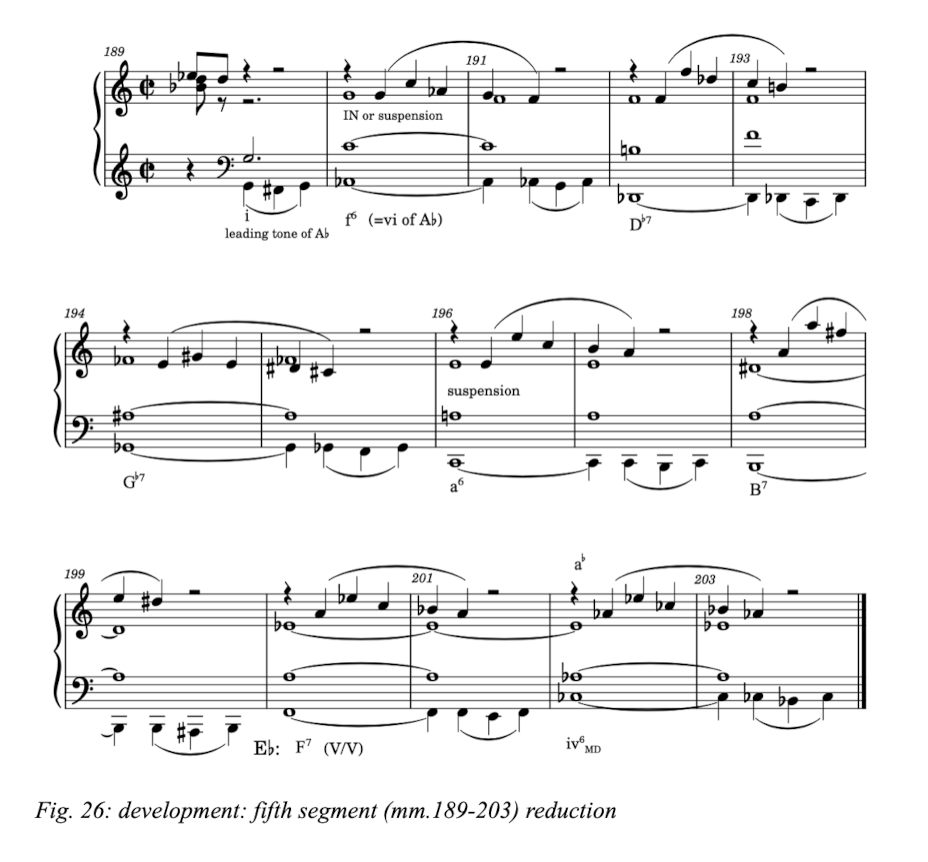
To start with the motivic structure: the a7 motive in the bass of the piano alternates with the a6 motive in the violin and cello. The a6 motive was first encountered in the first phrase of the first tonal area (fig.3). The dynamic is increasing again starting piano with swells in the violin and cello voices. This culminates in a forte and then still crescendo in m.202.
Harmonically this segment consists basically of a descending fifth progression in the bass notes, starting in m.190 with the A-flat. The sequence consists of A-flat – D-flat – G-flat – (a minor) – C-flat – F. Again the notation Schumann uses is not completely consistent and therefore fig.27 shows an alternative notation.
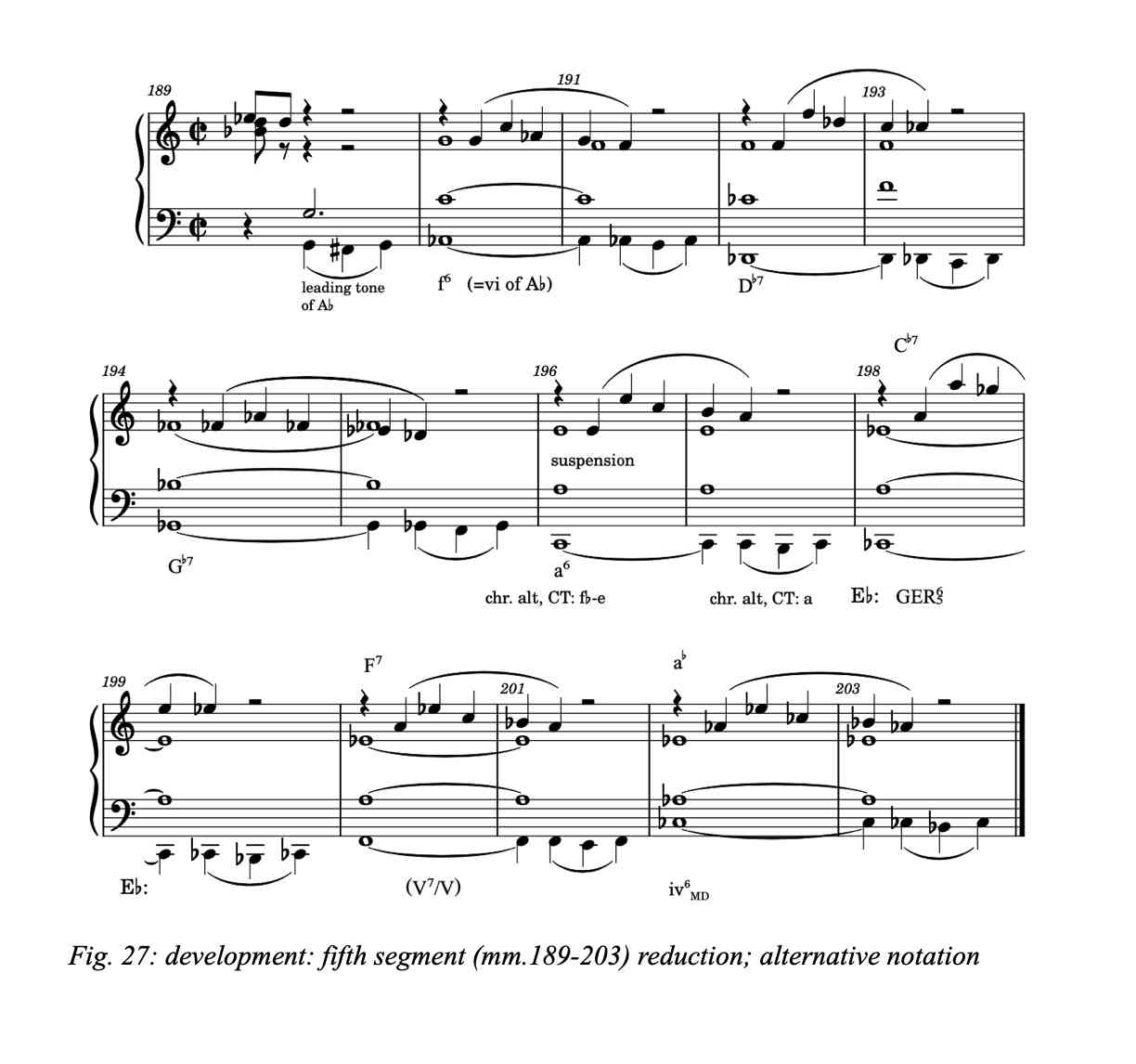
As shown there m.198 is not notated as a B dominant seventh chord but as a C-flat dominant seventh chord, a fifth below the G-flat dominant seventh chord in mm.194-195. Other small adjustments have been made, like the A-sharp in m.194. In fig.27 it is spelled as a B-flat, fitting in the G-flat chord.
A few things attract attention. First of all even though the descending fifth progression is clear in the bass notes, the harmonisation is sometimes different. Starting in m.190-191 the bass note A-flat is harmonised with a f minor chord (the submediant vi of A-flat major), which makes the progression deceptive. Likewise in m.196 the C natural is harmonised with an a minor chord. Both places are suspension constructions, be it that the resolution is on a different moment. In m.191 it is on the second quarter note, so within the two bar unit, in mm.196-197 the resolution is on the first beat of m.198, so the whole two bar unit is the suspension. This corresponds with the fact that the C natural does not fit exactly in the descending fifth progression. It is a leap of a diminished fifth which resolves to the C-flat which does fit in the descending fifth sequence. It is also clear from the voice leading: both m.196 and m.198 have a leap of an octave which increases the tension in the phrase.
There is also another diminished fifth progression. The F major chord in m.200 is a diminished fifth below the C-flat chord. Here however there is no question of a suspension. In fact the regions of E-flat major (the home key) have been reached as the C-flat dominant seventh chord in m.198 can be spelled as a GER65 in E-flat major, the F dominant seventh chord in m.200 as an applied dominant of the dominant of E-flat major and the a-flat minor chord in m.202 as a predominant moll-dur of E-flat (look here for a brief explanation of moll-dur).
As we shall see the next segment (6) is the standing on the dominant (B-flat dominant seventh chord) and concludes the development part of this movement.
Development: Segment 6
So this is the upbeat to the recapitulation (m.213) and a pretty turbulent one at that. Figure 28 gives the reduction. Measure 203 is shown also because of the change of motive from a6 in the previous segment to a8 in m.203 (see fig.29 for the motives overview) although the harmony is still the iv6MD chord.

This changes however in m.204 to the dominant of E-flat major, the B-flat dominant seventh chord alternating with the dominant ninth chord which stays like that until the recapitulation.
The a8 motive gets a more turbulent character with its variant in quavers (a12) starting in m.208. This is the same as the end of the piano ornament which was also found in mm.159-160 in the x2 motive.
Notice also the sforzandi starting in m.203 adding to the tempestuous character of this phrase. From m.208 onwards the sforzandi are on the weak parts of the bar (second and fourth quarter note) and the piano starts in m.210 with even more of beat chords. This leads to an apotheosis in m.212 which launches the fortissimo recapitulation in m.313.
This concludes the analysis of the development but not before giving an overview of the motives related to the first tonal area including the variants of the development. Note that the motives of the second part of the exposition as shown in fig.19 do not occur in the development. Figure 29 gives this overview.

Recapitulation
The rest of the movement consists of the following elements:
Measure
213-308
309-310
311-320
321-355
Section
recapitulation
bridge to slow introduction of the coda
slow introduction of the coda
coda
Table 3: layout of the first movement after the development.
The recapitulation is of course a restatement of the exposition but Schumann did make some variations which will be discussed next.
As can been seen in the score on the second beat of m.252 starts the restatement of the second part of the exposition. This is analogous to m.64 in the exposition (fig.13). So the restatement of the first tonal area (FTA-R) runs from the second beat of m.213 to the first beat of m.252, a total of 39 measures. The FTA in the exposition contains 51 measures (mm.13-64).
Let’s find out what Schumann did differently in the recapitulation.
Recapitulation: First Tonal Area (FTA-R)
As will be shown, again three phrases can be distinguished in the FTA-R. Table 4 gives the overview.
Section
2+2+4 sentence
4+4+8 sentence
4+4+7 sentence
Table 4: sections in the first tonal area of the recapitulation
FTA-R: first phrase (2+2+4 sentence)
This is the beginning of the recapitulation so in fact we expect the first theme as was stated in mm.13-26 (fig.3). Well, the similarity is evident but Schumann chose to vary on the theme. First of all the theme starts fortissimo, coming forth of the powerful ending of the development, with quarter notes and not with the quavers of the opening in the exposition. And then of course the ornamental cadence in the piano is left out. The theme is condensed to its essence. Figure 30 shows the reduction of the opening theme in the recapitulation. As can be seen there is it now a regular 2+2+4 sentence, including the prolonged dominant in m.220. In the exposition this opening statement is followed by the internal extension (mm.26-36, fig.5) after the modulation to f minor. Here it ends with a half cadence in E-flat major. So where the first sentence of the first tonal area in the exposition consists of 22 bars (including the extension), the first sentence of the recapitulation consists of 8 bars only.

FTA-R: second phrase (4+4+8 sentence)
After the powerful statement of the main theme there follows again a sentence starting in E-flat major and ending in A-flat major in m.237. The presentation of the sentence is the same as the presentation of the second sentence of the FTA in the exposition (fig.6). That is the x1 motive (fig.29) in E-flat major and then repeated in f minor, the super tonic op E-flat major (mm.221-229). This can be found in the reduction of this phrase in fig.31.

The second half of the sentence however is different. It is the a7 motive above a chromatically ascending bass line that starts on a G in m.229 second beat and after six repetitions it has reached G in the bass again (m.235). By way of comparison remember the descending bass line in the second phrase of the second half of the exposition (fig.16). It is a similar idea with different thematic material of course.
The harmonisation is interesting. In mm.230-231 Schumann uses a chromatic ascending sequence of diminished seventh chords. Notice the different inversions that occur in using this technique. The b diminished seventh chord in m.231 can be seen as the seventh chord of c minor which is the harmonisation of the C in the bass in m.232. In mm.230-235 the first beat is a passing chord.
From m.233 onwards they are preceded by their dominant. Look for instance at mm.233-234. The B-flat chord is the applied dominant of the e-flat minor chord on the first beat of m.234. The same goes for the C major chord in m.234 but this time it resolves deceptively to the VI of f minor, being D-flat major. This chord can also be read as the predominant IV of A-flat major so this is the point where the cadence leading to A-flat is reached.
The applied dominants are all in first inversion as is the passing chord on the first beat of m.235. So this gives the impression of a fauxbourdon (look here for a brief explanation). There are some irregularities however: the e-flat minor chord on the first beat of m.234 is in root position and in m.235 the F on the first beat is harmonised with the D-flat major chord with its twofold functionality and then a whole step is made in stead of a semitone to be able to create the dominant of A-flat major. Both the predominant and dominant chords are in first inversion, fitting in the fauxboudon like progression.
FTA-R: third phrase (4+4+7 sentence)
The third phrase is again a sentence which very much resembles the second sentence of the first tonal area (FTA) of the exposition (mm.36-52, fig.6). There are a few differences however. First of all the keys used. Whereas the sentence in the exposition starts in E-flat major and progresses towards its dominant B-flat, in the recapitulation the start is a fifth lower in A-flat major (the predominant of E-flat) and ends also on its dominant, E-flat major, being the home key of the piece.
As can be seen in fig.32 the number of measures in this sentence is 15 (4+4+7) whereas in the exposition it is 16 (4+4+8).

The difference is m.51 which repeats motive a9 as in m.47 (m.248 in the recap). In the recapitulation this measure is left out. I think this is done because of what comes next. In the exposition a restatement of the opening theme follows and it gets a flying start with the half cadential version of motive a9. Here in the recapitulation it is the end of the first tonal area (m.252). The feeling of closure is much stronger also as a result of the authentic cadence (mm251-252 first beat). After this the repetition of the second half of the exposition starts (m.252 second beat).
The harmonic progression in both sentences is very similar. There are two small differences. Look at the second beat of m.44 and of m.245, the corresponding measures in these sentences. In m.44 the second beat is a G major chord to be interpreted as an applied dominant of the next chord (c minor, in the analysis given the function of a iv of g minor). In m.245 the second beat is a c minor chord which in my analysis happens to be the local tonic of the prevailing tonicization. The same holds for the first half of m.45. respectively m.246. So in the exposition the c minor chord is accentuated (possibly because is the relative of the tonic E-flat). No need to do that with f minor in the recapitulation. It is of course the relative of A-flat major, on a larger scale the tonic we are into, but in a still larger perspective A-flat is ‘only’ the subdominant, so no need to emphasise its relative minor.
Or did Schumann want to keep it more orderly (i.e. diatonic) in the recapitulation? If you have any thoughts about this, please leave a comment at the end of this post.
The other thing that is slightly different is the chord in m.248. This a A-flat seventh chord, here analysed as a pivot from a VI7 in c minor to a IV7 in E-flat major. One might consider to spell it as a GER65 in c minor, in which case the G flat should be read as an F sharp. However, then we expect a solution towards G in m.249, which is not the case as Schumann takes another turn (to F7). So the chord in m.248 can probably best be seen as a passing chord.
In the corresponding m.47 in the exposition there is no seventh in the chord so there it is a switch from a VI in g minor to a IV in B-flat major.
Surveying the harmony of the first part of the recapitulation there is first a pithy statement of the main theme (first phrase, mm.213-221) in the tonic E-flat major. Then harmonically the next two phrases can be summarised as:
Tonic – Sequencial progression – Subdominant – Sequencial progression – Chromatic alteration – Dominant – Tonic
With measure numbers added:
Tonic (221-224)- Sequencial progression (224-234) – Subdominant (235-241) – Sequencial progression (241-248) – Chromatic alteration (249) – Dominant (250-251) – Tonic (252)
Recapitulation: The second part of the exposition
The second part of the exposition in the recapitulation runs from m.252 second beat to m.308 and is in fact a copy of the corresponding section in the exposition, but one fifth lower. It is thus home key oriented although the same ambiguity is present, this time between E-flat major and its relative c minor.
The medial caesura as mentioned in the Reconsideration of the second part of the exposition is here to be found in m.276. In the exposition it is in m.88.
The Coda
The slow introduction to the Coda
Figure 33 shows the introduction to the Coda. No need to say that the effect of the half and whole notes is that of a slow tempo as in the Sostenuto of the beginning, taking into account again that we are in alla breve time.

Measures 309 and 310 correspond to mm.121-122 of the introduction of the development. They are the bridge to the slow introduction itself starting in m.311 with the minor sixth leap we encountered already in m.1 and m.123 (fig.20). The exposition in the recapitulation ends on E-flat (mm.307-308) whereas the exposition ends on B-flat (mm.119-120). As the B-flat immediately changed function to the dominant of E-flat in m.123, so does the E-flat in mm.309-310 changes to the dominant of A-flat major, the subdominant (IV) of the home key.
From m.213 onwards the slow introduction is different from its predecessors. Schumann proceeds with an ascending sequence which consists of three steps down and four steps up (an A2(-3/+4) sequence; see notational syntax on sequences for an explanation). Notice how Schumann uses a stepwise ascension in the tenor and alto voices for the leap down with a third (which end up in a first inversion).
This is a diatonically sequence until the surprise on the second half of m.317. Here the progression is not to an A-flat but to an A natural. It is the dominant region of B-flat major, the dominant of the home key. The alto and the tenor take us down from a seventh half diminished chord (m.317) to the dominant seventh chord of B-flat (second half of m.319).
The Coda
Here we enter the final part of this movement, at first quite fresh and energetic, then contemplative and with a final sweep it comes to an end. I will look at the form and harmonic structure and the motives used.
I think the Coda consists of three parts:
- The Più agitato (mm.321 with upbeat – 337 first beat)
- the contemplative reminiscence (mm.338-347 first beat)
- final sweep (mm.347 second beat – end)
The Più agitato. [H4]
Figure 34 shows the reduction of the Più agitato.

The form and harmonic structure
The Più agitato starts with a basic idea of two bars in the dominant which is repeated in the tonic, played by the cello. This is the presentation of a sentence. It is not a statement-response presentation (I-V), but rather the inverse of it (V-I). We have seen this before of course in the second part of the exposition (fig.13). This presentation is then repeated with the violin joining in (mm.325-328).
The continuation starts in m.329 and shows immediately a fragmentation of the basic idea (i.e. the first bar m.321 with a slightly altered rhythm), once repeated (m.330). What follows is a cadential progression which resolves deceptively on vi in the second half of m.332 preceded by its applied dominant. This continuation is also repeated, one octave lower and this time it resolves with a perfect authentic cadence (PAC) in the home key.
The agitato character is supported by the quavers in the piano, violin and alto, which change to a syncopation every other bar. Added to this are the truncated triplets in the violin and later in the alto. We have seen this before in the fourth segment of the development (mm.180-189; look in your score for this. The reduction [fig.25] doesn’t show these rhythms).
So far for the form and harmony. Now let’s look at the motivic material Schumann uses.
The motivic material
The motive with which the Più agitato starts is not a literal copy of something we have seen before but it isn’t completely new either. Notice that in fact there are two motives: one in the tenor voice played by the cello and the other contrapuntal one in the bass, played by the left hand of the piano.
It is probably clear that when searching for the origins of these – obviously related – motives we should look at motive a and not at the motives of the second part of the exposition (motives b through d). In fig.29 the overview of the a-motive family is shown.
As the melodic similarity is not immediately clear we can look for a rhythmic analogy[15]“THE PRESERVATION OF THE RHYTHM ALLOWS EXTENSIVE CHANGES IN THE MELODIC CONTOUR” in Schönberg, Fundamentals of Musical Composition, 30. and this we find in the second and third bar of the x1 motive (fig.35a). Comparing this with the tenor voice in mm.321-322 of the coda we see that the rhythm is identical. So Schumann made a variation on part of the x1 motive to start the coda. What intrigues me is how we can relate the variant of the coda to the x1 motive. I came up with the following reasoning.

If the ornamental notes were to be left out then the first note to skip is the F natural in the first measure, which would lead to a reduced motive as shown in fig.35b. If then the A-flat in the second bar is also left out we get something as shown in fig.35c. Comparing this to the motive of the coda (fig.35d) we already see a remarkable resemblance. Of course the direction of the run of the quarter notes is opposite. Apparently here also some mirroring is going on. In fig.35c second measure, stepwise down and a fourth up and in fig.35d a fourth down and stepwise up. So this is horizontally mirrored.
In fig.35e the contrapuntal voice in the bass is added. The voice in the bass is mirrored in the first measure and then continues as in motive x1, be it in a different register to fit in the key of B-flat major. In the tenor the first measure is as in the (reduce) motive x1 and then the motive is mirrored.
Only one aspect has to be accounted for: the upbeat to m.321 as shown in fig.35f. I would say this is derived from the sixth leap in the bass in the very first measure of the movement which is repeated in m.123 (see fig.20) and then again repeated in m.311 (fig.33). When looking at the motive in the bass, the F-A leap downwards is also a minor sixth and the direction is in accordance with the mirrored direction of the beginning of the x1 motive in the bass in m.321. As a result the leap in the tenor is a seventh.
The contemplative reminiscence
After this rather turbulent start of the coda follows a really intimate remembrance of the main theme in the lyric style (larger part of motive x1). Figure 36 shows the reduction. This starts after the ritardando in a slower tempo in the cello (m.338) and then the viola (m.340) and the violin (m.342) are added in an imitative texture. Passing through the subdominant in mm.341-343 it ends after an open-ended viio7 on the tonic in the first beat of m.347 which kicks off the final sweep to the end of the movement.

The final sweep
The a tempo in m.347 starts with a sequence of the a3 motive. Harmonically this sequence very much resembles the sequence in the second phrase of the first tonal area in the recapitulation (fig.31) and more precise the mm.229-232. The first occurrence of the sequence with the G in the bass (m.229 resp. m.347) is now harmonised with a I6 of E-flat major whereas in m.229 is g minor. Once arrived on the A in the bass the harmonic progression is the same.
In the coda c minor is reached in m.350 and functions here as the vi of E-flat major. It is the predominant start of the final cadential progression.
And this ends the analysis of this first movement of Schumann’s piano quartet.
Notes
| ↩1 | First tonal area (FTA) and Second tonal area (STA) are terms introduced in Steven G. Laitz, The Complete Musician: An Integrated Approach to Theory, Analysis and Listening (4th Ed (New York [etc.]: Oxford University Press, 2016), 632. |
|---|---|
| ↩2 | The concept of sentence as theme type can originally be found in Arnold Schönberg, Gerald Strang, and Leonard Stein. Fundamentals of Musical Composition (London: Faber and Faber, 1967), 21 and is further explored in William E. Caplin, Classical Form: A Theory of Formal Functions for the Instrumental Music of Haydn, Mozart and Beethoven (New York [ect.]: Oxford University Press, 1998), 37-39. |
| ↩3 | See for instance: Laitz, The Complete Musician, 571-572. |
| ↩4 | Florestan and Eusebius are the fictional characters Schumann introduced in 1831 following the writer Jean Paul. They represent the turbulent respectively reflective side of the same person (Schumann himself). Schumann connected the words rasch respectively innig to them. For more information on the introduction of these characters, see for instance: John Daverio, Robert Schumann: Herald of a “New Poetic Age” (New York etc.: Oxford University Press, 1997), 74-75. |
| ↩5 | Caplin, Classical Form, 39. |
| ↩6 | this quote is cited from: Daverio, Robert Schumann, 119. |
| ↩7 | Daverio, Robert Schumann, 113. |
| ↩8 | cited from: Daverio, Robert Schumann, 119. |
| ↩9 | cited from: Daverio, Robert Schumann, 119. |
| ↩10 | Daverio, Robert Schumann, 249. |
| ↩11 | Hepokoski, James A, and Warren Darcy. Elements of Sonata Theory: Norms, Types, and Deformations in the Late-Eighteenth-Century Sonata (New York [etc.]: Oxford University Press, 2006). |
| ↩12 | This is not “the second part of the exposition” according to Hepokoski and Darcy because in their theory there is no second part of the exposition in this composition, which would be the subordinate theme and an optional closing section. |
| ↩13 | Hepokoski and Darcy. Elements of Sonata Theory, 44. |
| ↩14 | Schumann is not very consistent is his notation here. The piano has a F-double sharp in the right hand which belongs to a d-double sharp diminished chord. The viola has a G natural, which is enharmonically the same note as the F-double sharp but belongs to an e diminished chord. As the current key is c-sharp minor the d-double sharp variant is more fitting. |
| ↩15 | “THE PRESERVATION OF THE RHYTHM ALLOWS EXTENSIVE CHANGES IN THE MELODIC CONTOUR” in Schönberg, Fundamentals of Musical Composition, 30. |
Recent Comments